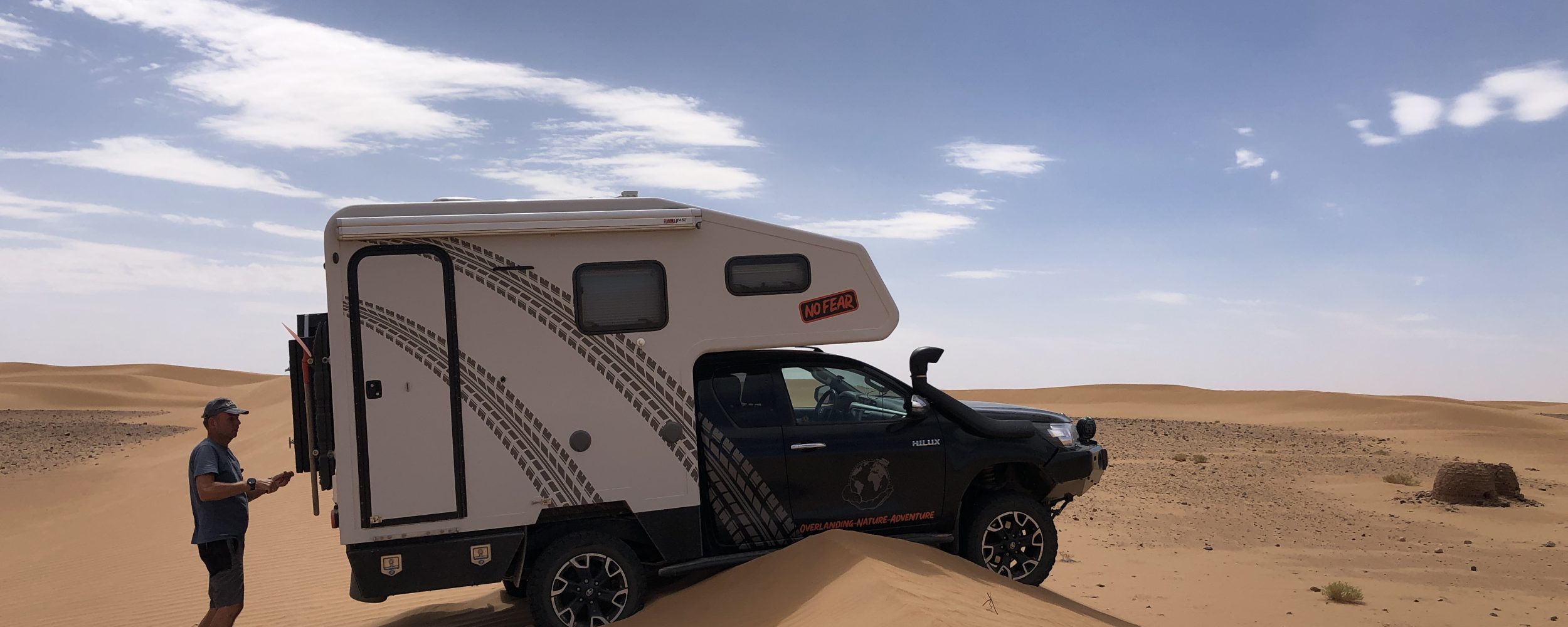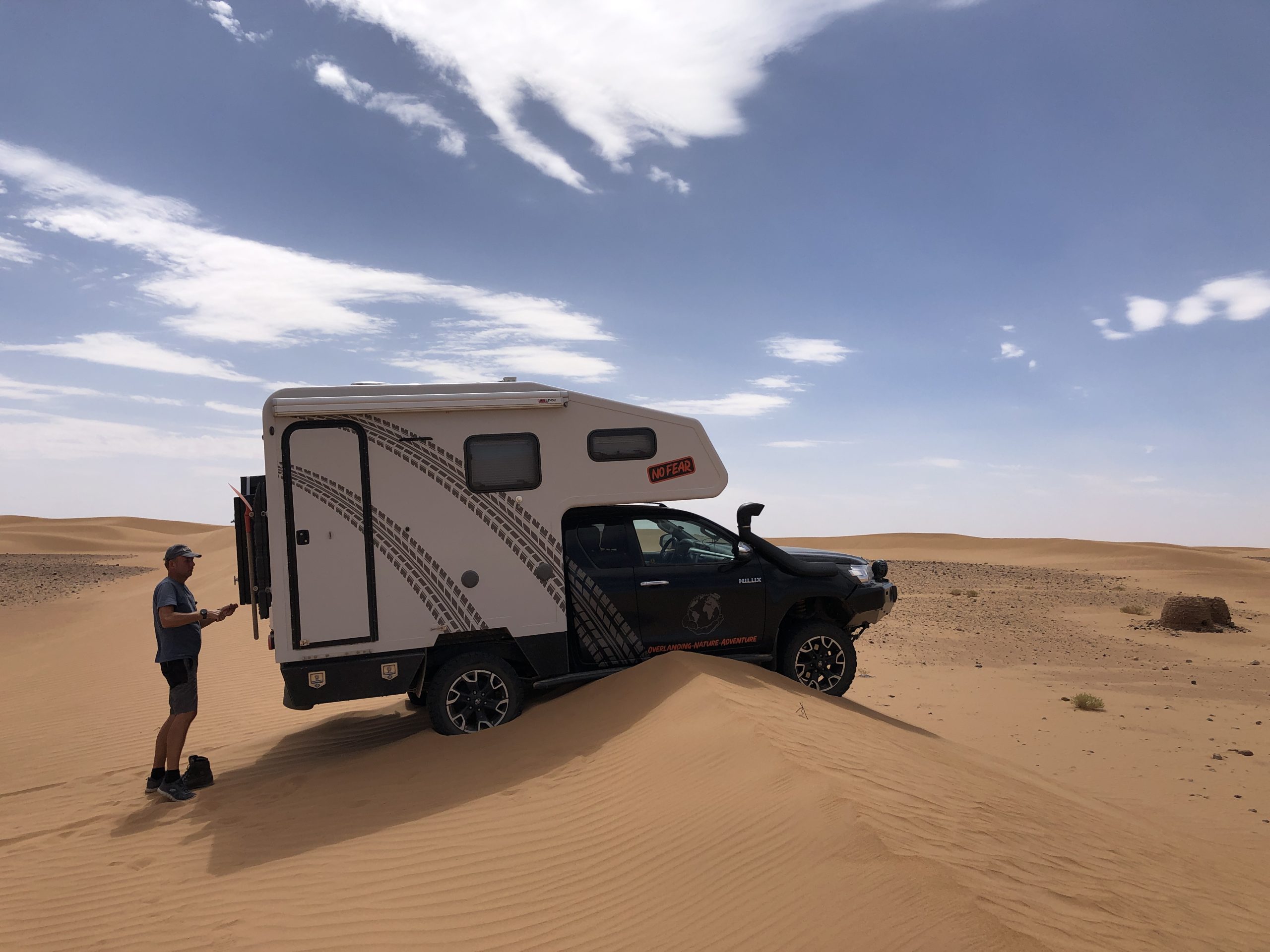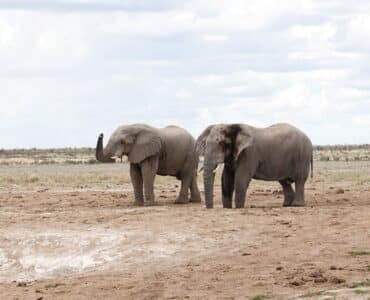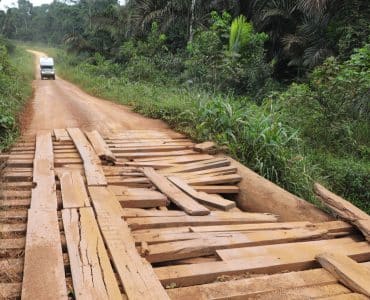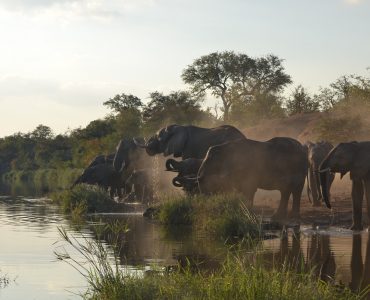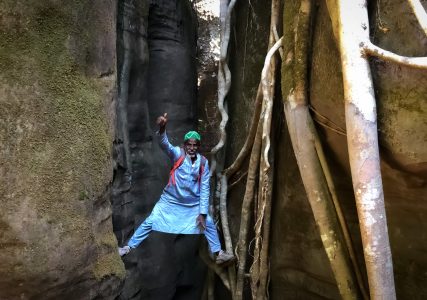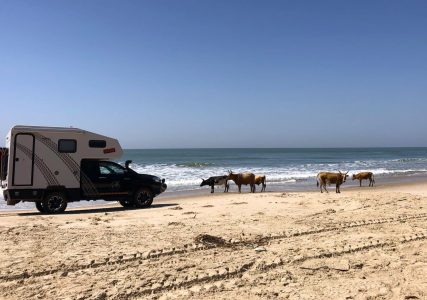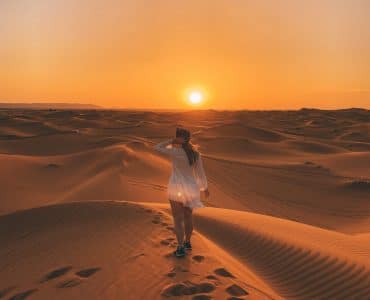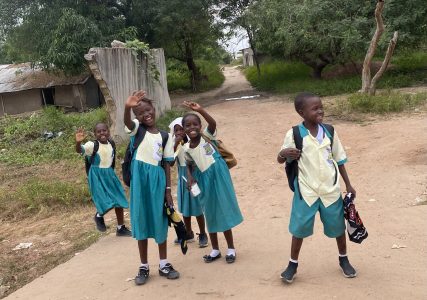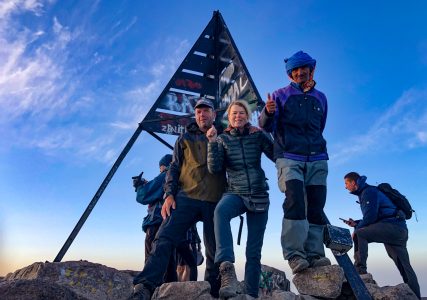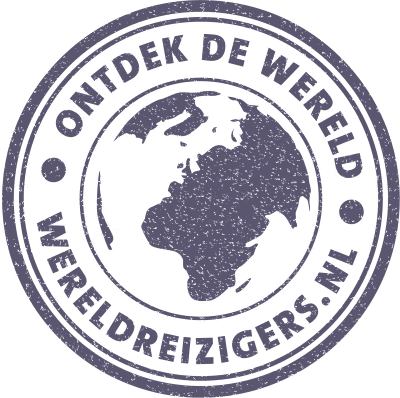We (Cor and Grietje van NoFear Travel), travel with our Toyota Hilux 4×4 camper by Africa. The African continent is the Mecca for 'overlanding' with many challenging routes and beautiful destinations. The first African country we visited during our trip to South Africa is Morocco, where we climbed the Toubkal mountain (4167 m). In this article we tell you everything about the continuation of our journey through Morocco to Mauritania. We met other overlanders, braved a Via Ferrata, drove through the Dades valley and got stuck in the dunes with our Toyota 4×4.
From Ouarzazate to the border with Mauritania
After the ascent of the Toubkal, our journey through Morocco continues in the direction of Ouarzazate (Location here). Cor has been quite ill for a few more days with symptoms of cramps, nausea, fatigue and shortness of breath. Altitude sickness or something wrong? Both could easily be done. But after a few days of taking it easy it's fine again.
Upon arrival in Ouarzazate, we are amazed at the progressiveness of the medium-sized town. Large wide streets with more luxurious cars instead of donkeys, horses and goats on the street. Many, tightly painted buildings determine the image. The city is cut in half by a dry river. This time we decide to spend the night at a campsite. Sometimes we do that when we need to wash or shower.
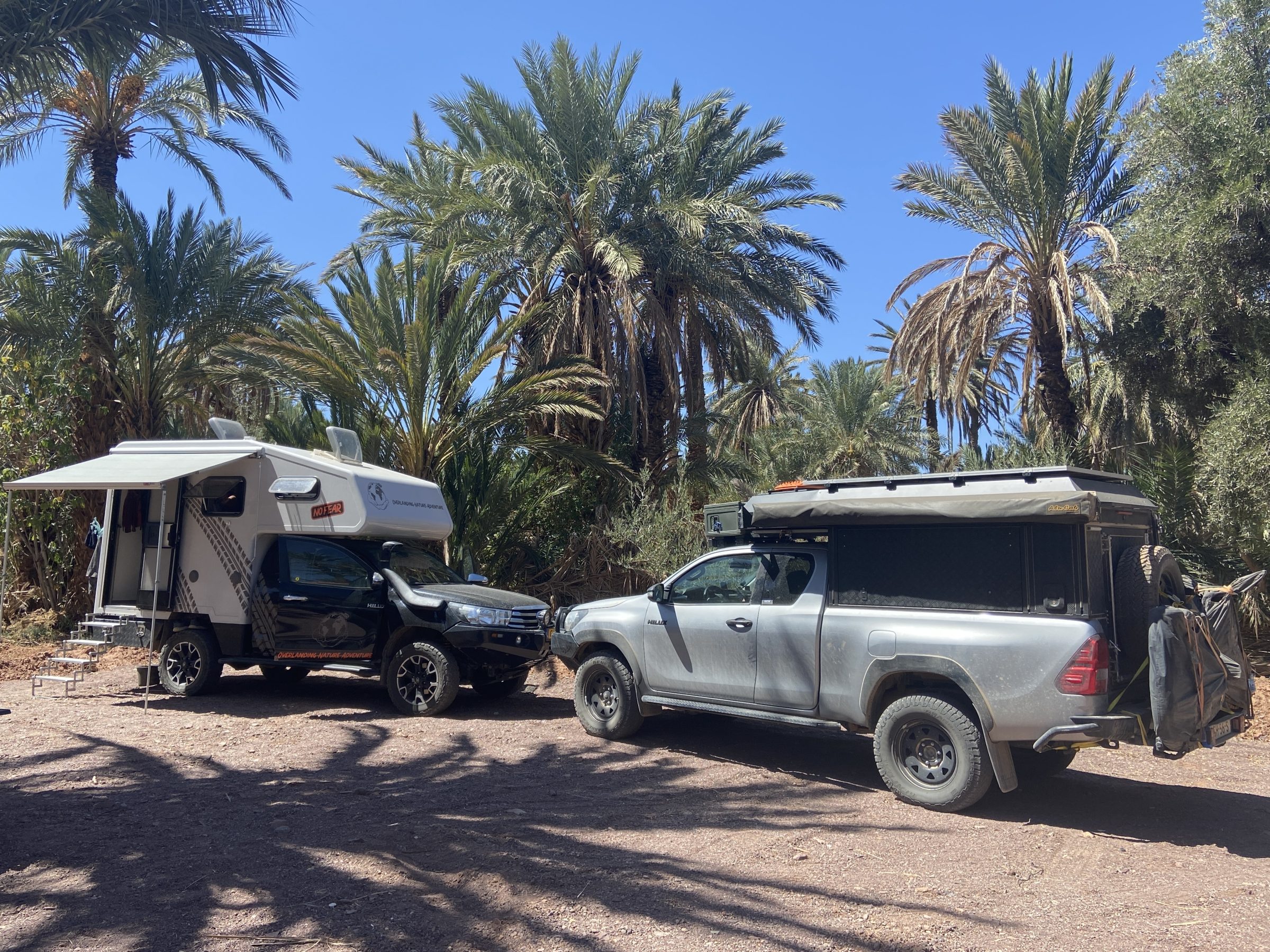
At the campsite we meet a German and Dutch couple overlanders. The German couple drives an expedition truck and the Dutch one in a Toyota Hilux. These kinds of encounters are very valuable. As like-minded people, we chatted and exchanged travel stories all afternoon. At the end of the afternoon we made joint use of the adjacent swimming pool and had dinner together in the evening.
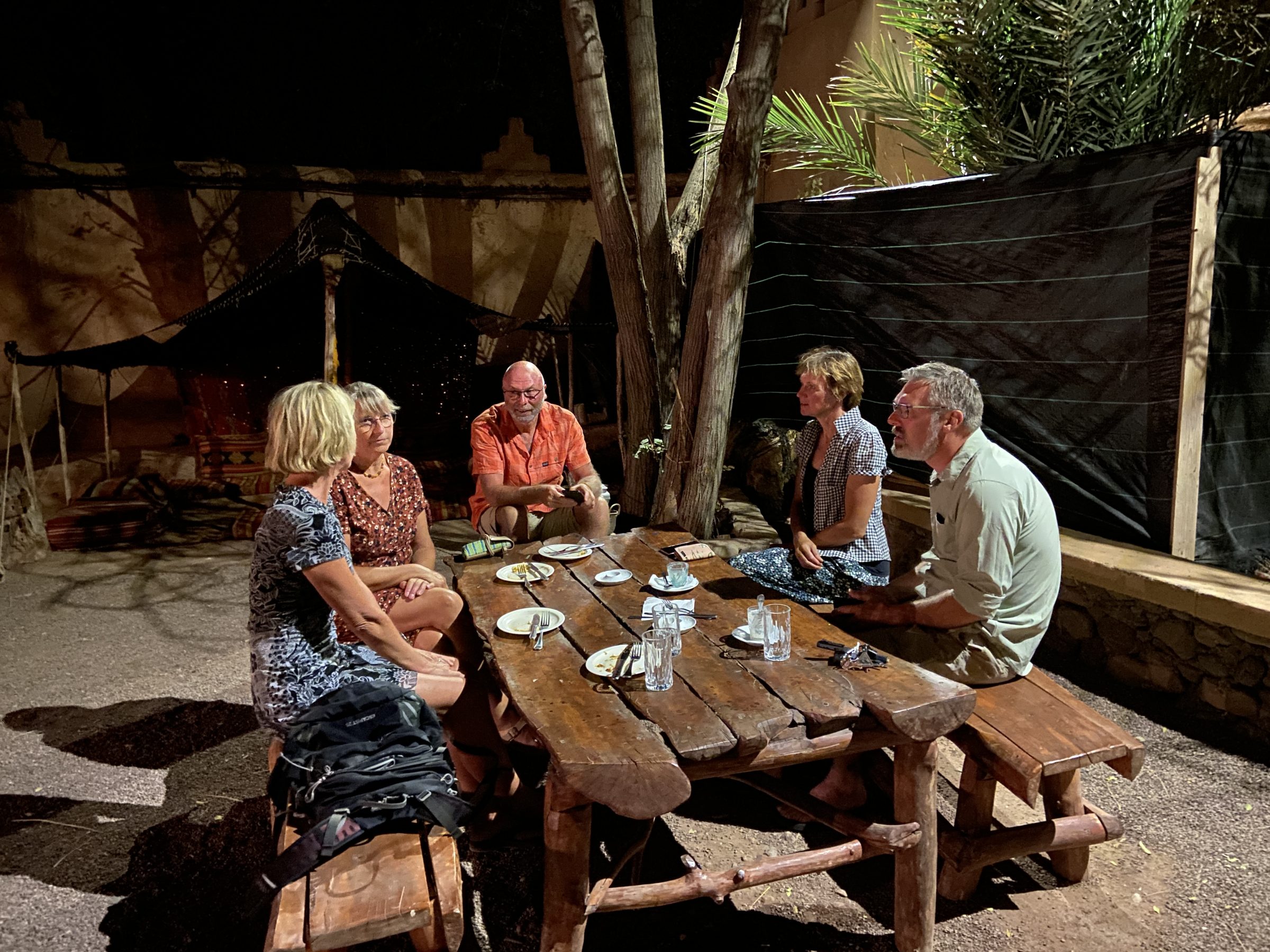
But yes, you often do overlanding alone. So the next day we parted ways and we have another nice bunch of acquaintances.
The Dades Valley
The Dades Valley (Location here) is one such attraction that many travelers don't want to miss. Attractions like this put us in despair. Yet this time we make the choice to pass by. Then we at least know about the hat and the brim.
We drive through a beautiful valley in a beautiful landscape. Beautiful winding roads and beautiful views. Unfortunately, our view is often blurred by the loud hotels and restaurants. It is now fairly quiet, but you can see from everything that people are used to many tourists.
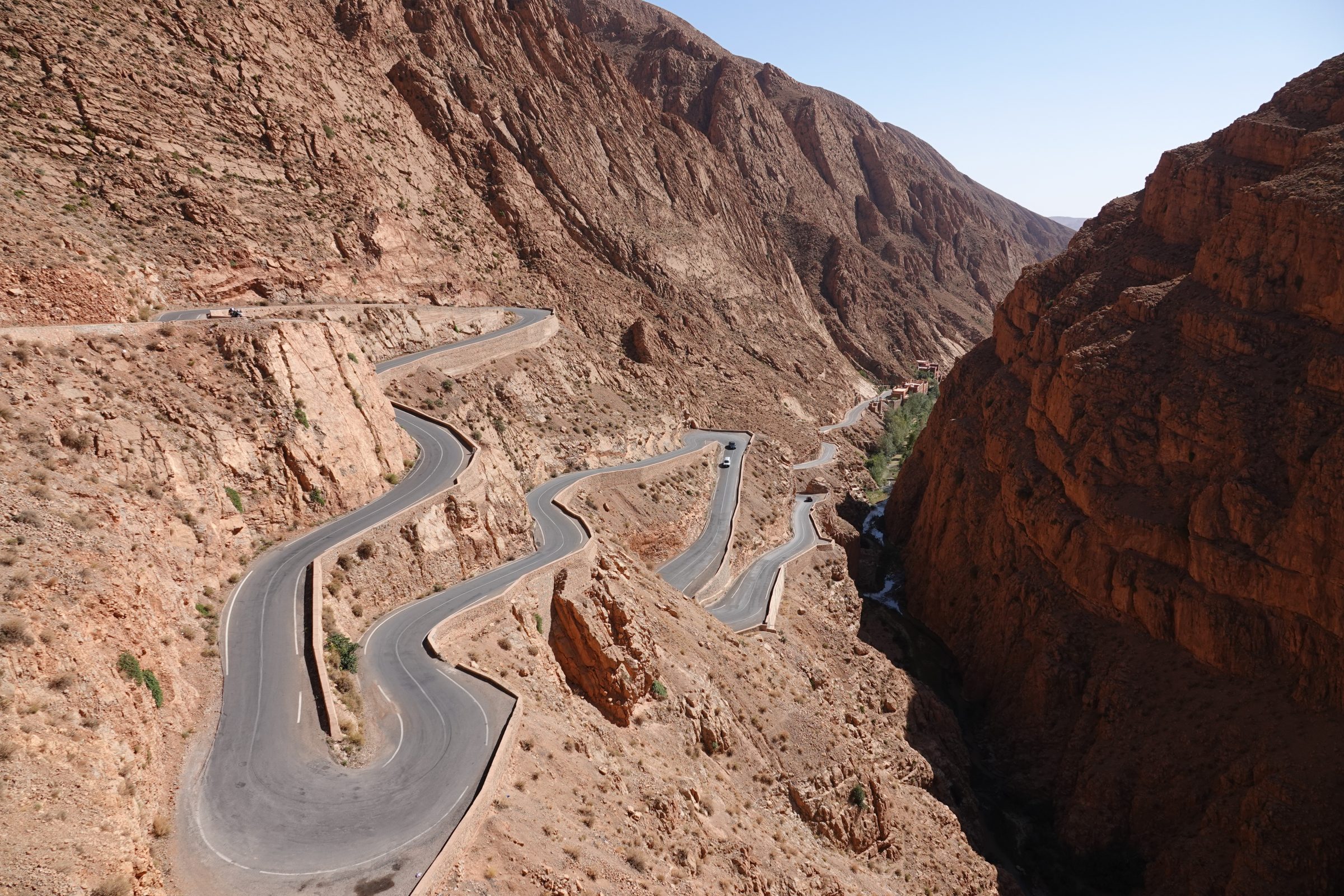
At the end of the valley, the road rises sharply through a number of hairpin bends. At the highest point is a restaurant from which you have a beautiful view over the bends and part of the valley. We also take the frequently taken photo here.
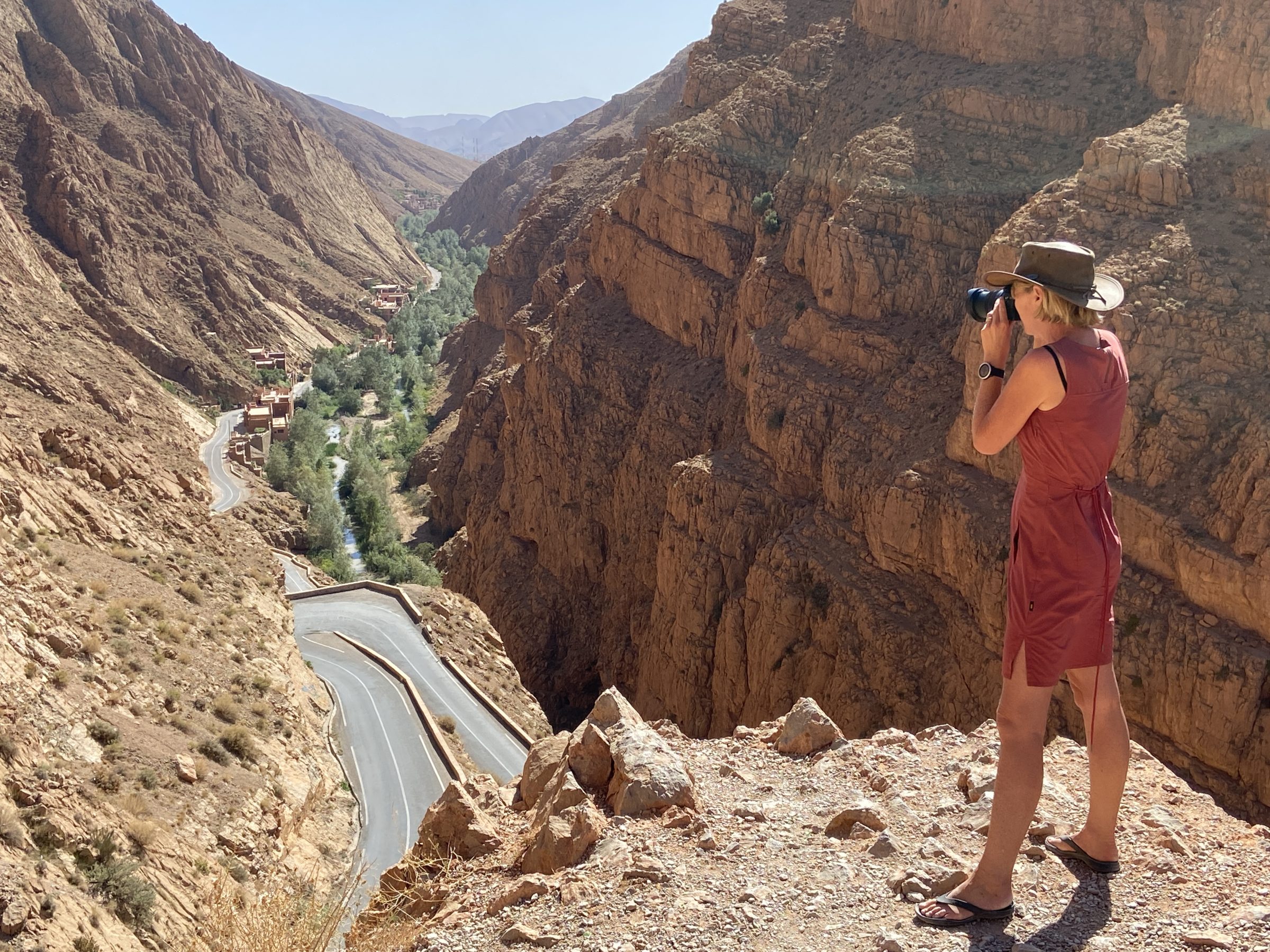
Between the Dades valley and the Todra gorge
From the Dades valley we take an off-road track straight through the mountains towards the Todra gorge (location here). An incredibly beautiful ride with phenomenal views.
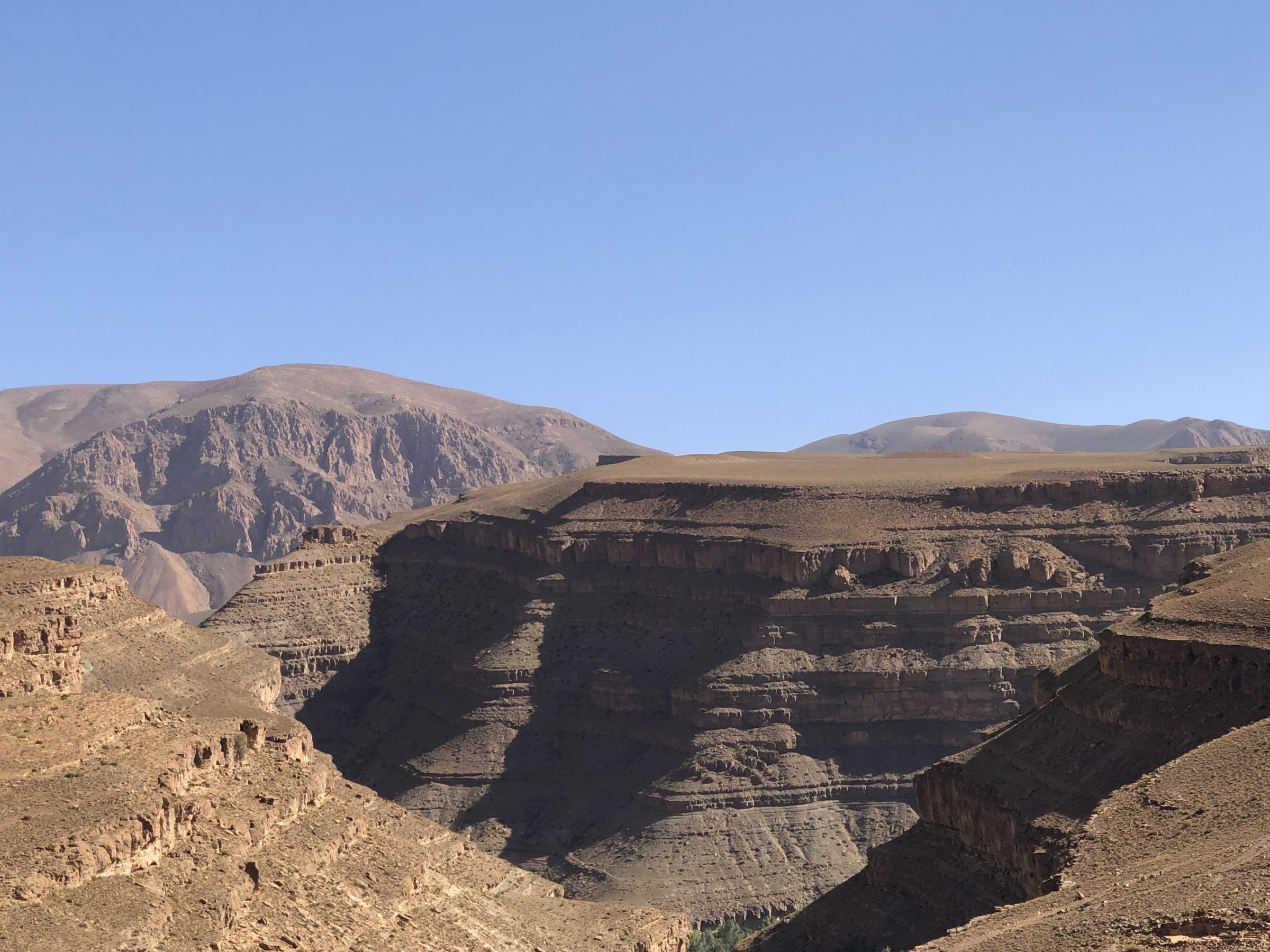
It is extinct, we don't see anyone else, until we see a Dacia Duster along the path. Not the most sensible vehicle in these circumstances. And indeed, the Moroccan family has a flat tire, but without proper tools. Fortunately, we have everything on board to help them get back on their way. As a thank you we are invited the next day to their restaurant in village dyeing.
We drive a little further and see here and there tents of Berber nomads. Children and adults run to the path and point to their mouths or make a "money gesture" with their hands. Always a difficult moment!
We can “drink tea” with every family, but then we will never get to South Africa. A little further - out of sight of the nomads - we find a nice place for an overnight stay along the road.
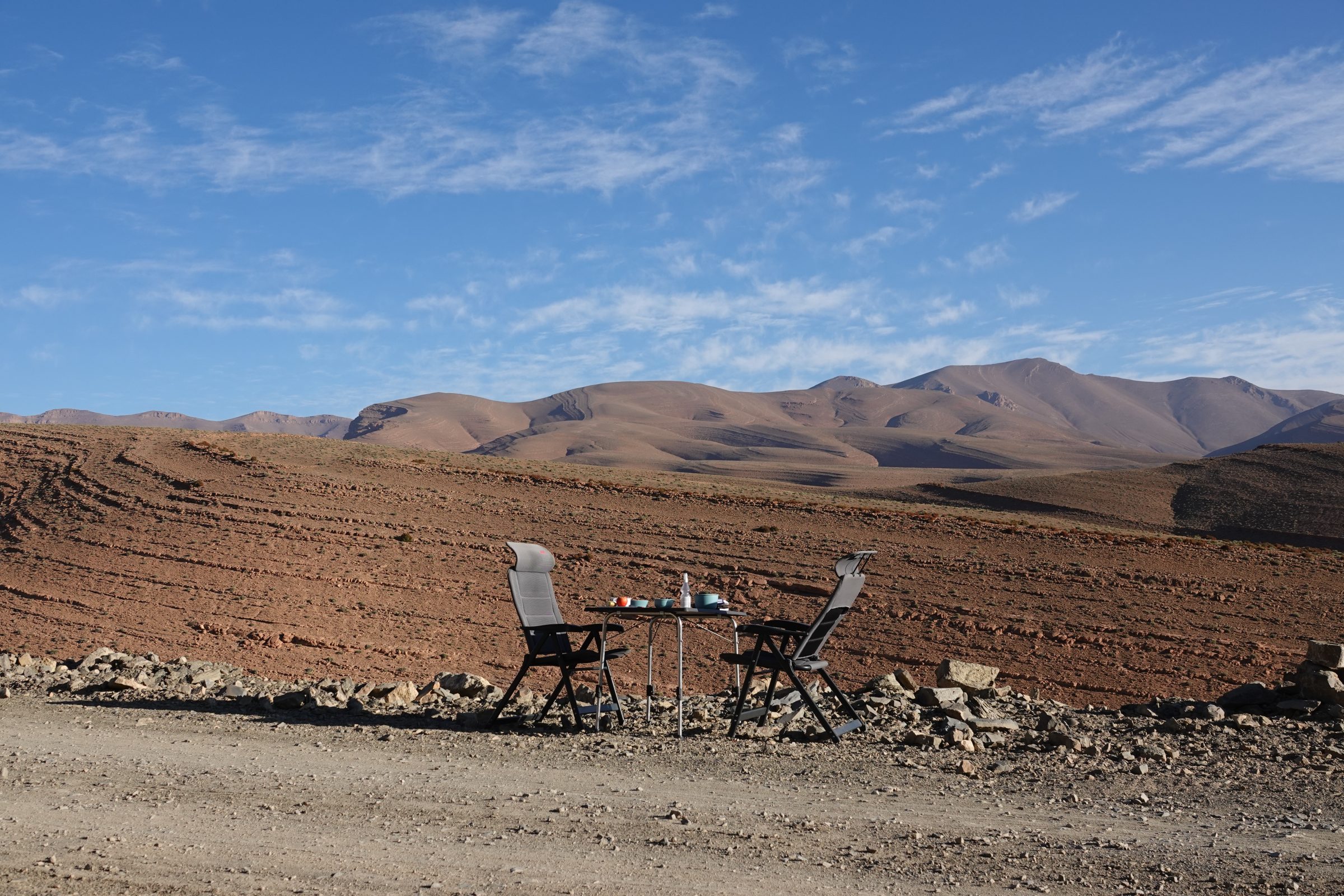
The Todra Gorge
When approaching the Todra gorge, we suddenly discover that a Via Ferrata has been set out here, against the mountain wall of the gorge. There is even a rope bridge in the route! It turns out to be the only African Via Ferrata. We dig deep into our box of climbing gear and tie the safety harnesses around our waists. What luck, we hadn't counted on that. We climb up and from there we have a nice view over the gorge.
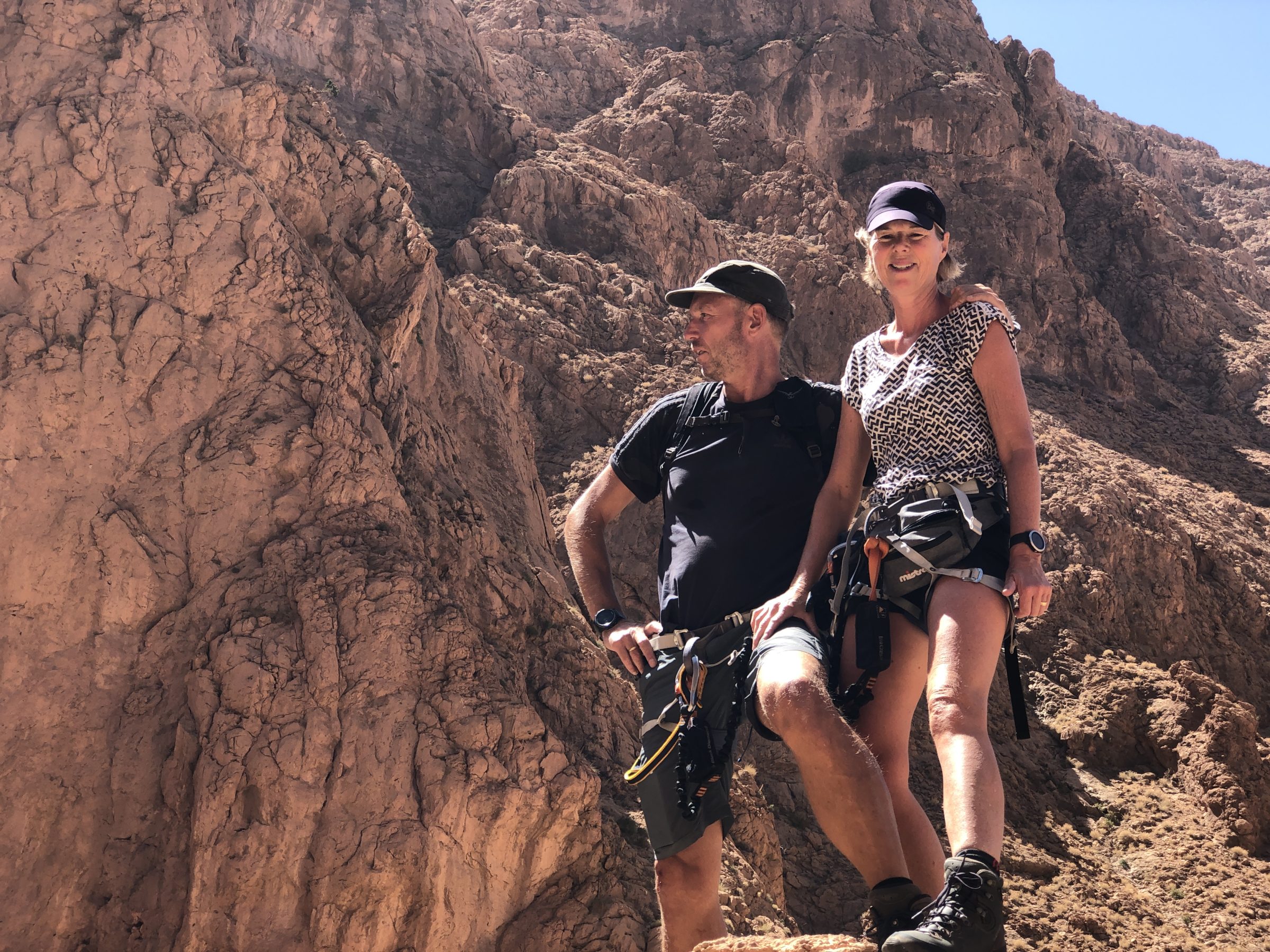
It's hot, so the trickles of sweat run down our cheeks, but it's well worth it. Later we clean up our things and go with the 4×4 camper through the gorge where there are many sales stalls, especially carpets and headscarves. People are picnicking on the banks of the river. It all looks nice.
Everyone wants something from us!
Sometimes the begging becomes a bit too much for us, this day is one of those, everyone apparently wants something from us. When we drive away from our overnight place in a dry river bed, another man comes rushing towards us. We immediately know what he wants from his movements… but we ignore him and drive away…
A little further in Erfoud (location here) let's go shopping. When we park, a group of begging boys is already gathering around us. We try to keep them away from us a bit, but that seems impossible.
Then another shop owner comes running and offers his wares. If we hold back, we get an unfriendly “look, don't buy” thrown at us. In the end we do some shopping further on and flee the village. Too touristy!
Tea with the Berber nomads
On the way we sometimes see some Berber settlements. A man with a baby comes running to one of them and asks if we want tea. We know that game by now, but we are also curious about their living conditions. We accept the invitation and a little later we sit on a cushion against a mud wall surrounded by a Berber family. The family consists of about 15 people, young and old. It is striking that at least four children are mentally and/or physically handicapped. We suspect inbreeding.
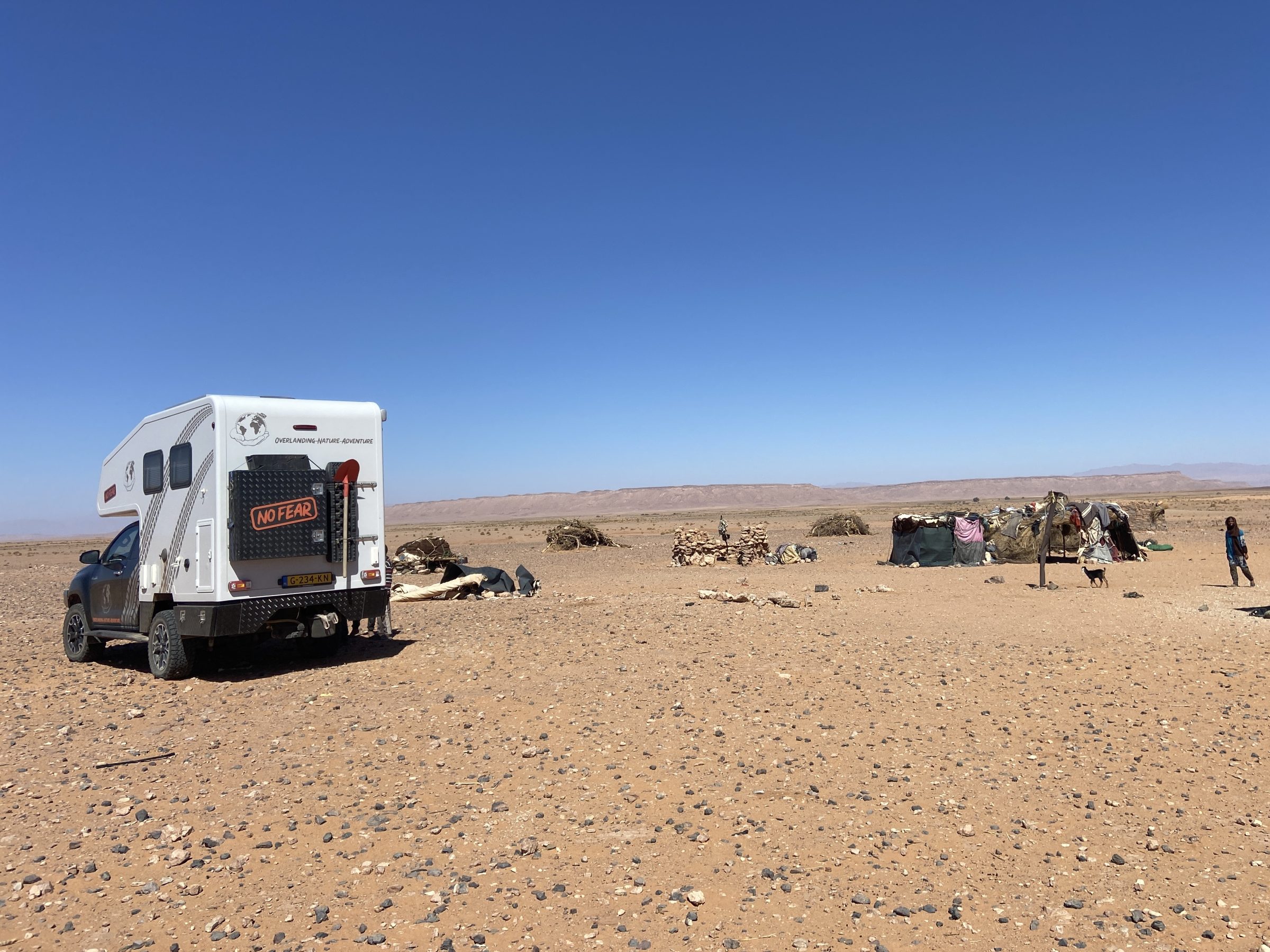
The conditions are downright primitive. Goats, sheep, dogs and cats roam and relieve themselves all over the yard. Yet there are also signs of modern business. For example, we are presented with cookies that they couldn't possibly have baked themselves. They also had to buy the peanuts and enormous amount of sugar in the tea somewhere. A little later we see an old moped around the corner. Apparently someone from the family is plodding through the deep sand to the village 25 kilometers away to do some shopping. But what do they pay for that…?
Erg Chebbi
We drive on to Erg Chebbi (location here), the dune area north of Merzouga (location here). The closer we get, the more the huge sand humps impress us. We are going to have a lot of fun here. We spend the night at one of the many campsites with a swimming pool.
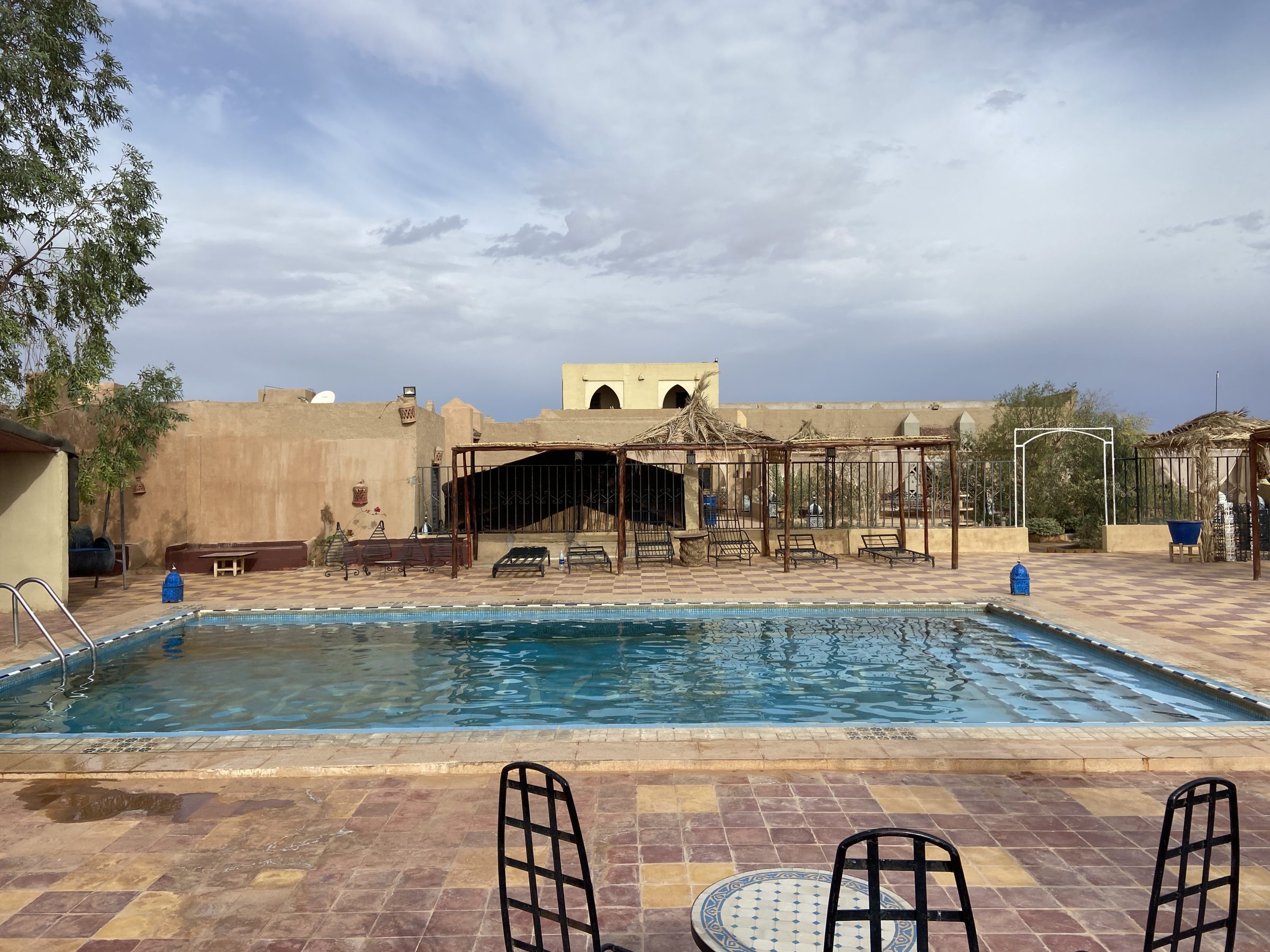
During the morning we will try to climb the top of the dunes. It's soft sand, 160 meters up, so that takes a lot out of our fitness. During the climb we enjoy the maximum. What a beautiful natural phenomenon!
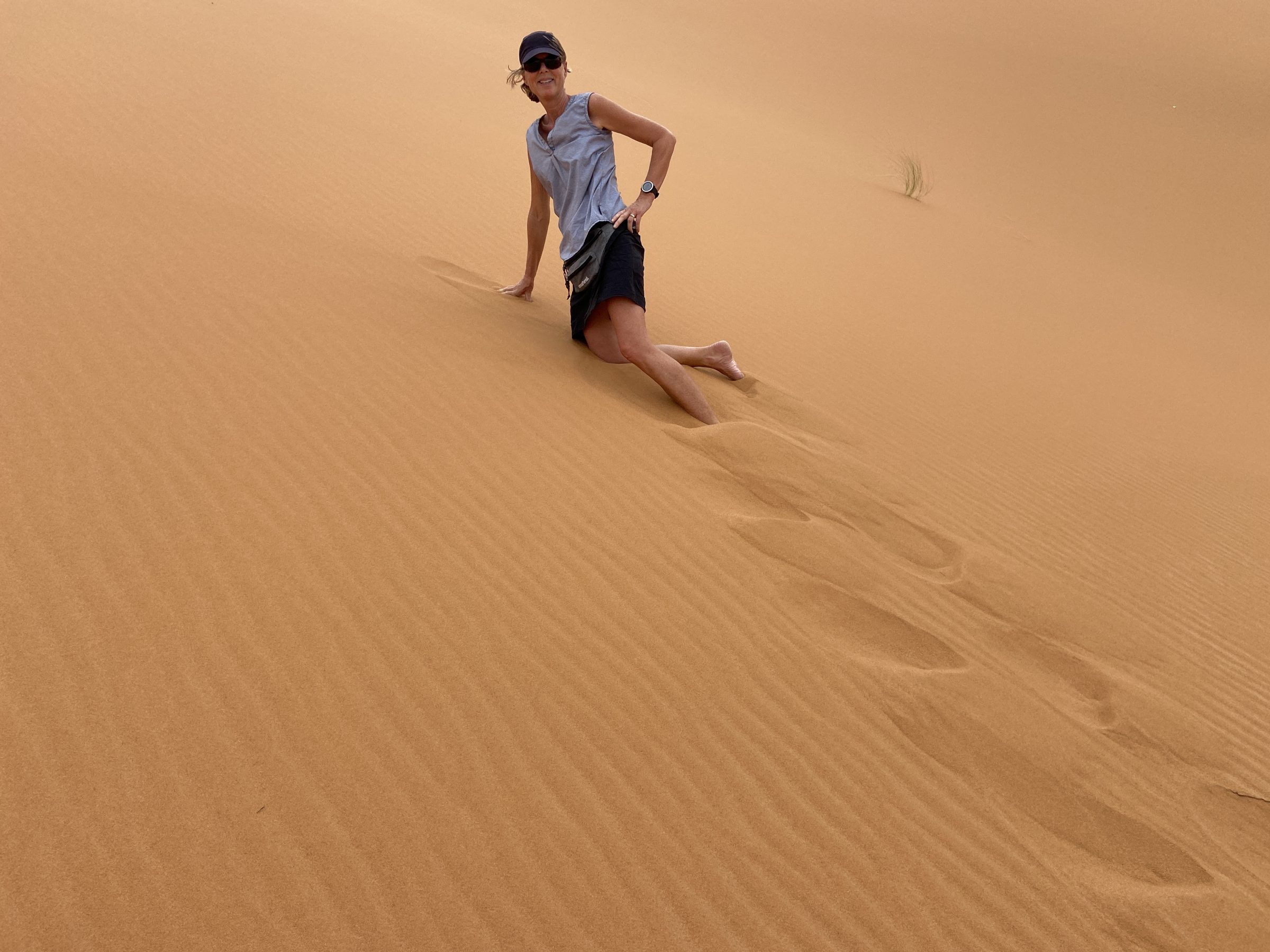
After we have climbed to the top we have a fantastic view. As young dogs we play in the sand and take pictures and videos.
Slowly we lower ourselves again. The wind is blowing harder and harder and so there is more and more dust in the air. Visibility in the area is greatly reduced, everything is gray. A sandstorm! Back at the camper we don't really know where to sit, inside or outside. The fine sand is everywhere! We will experience this more often in the coming weeks.
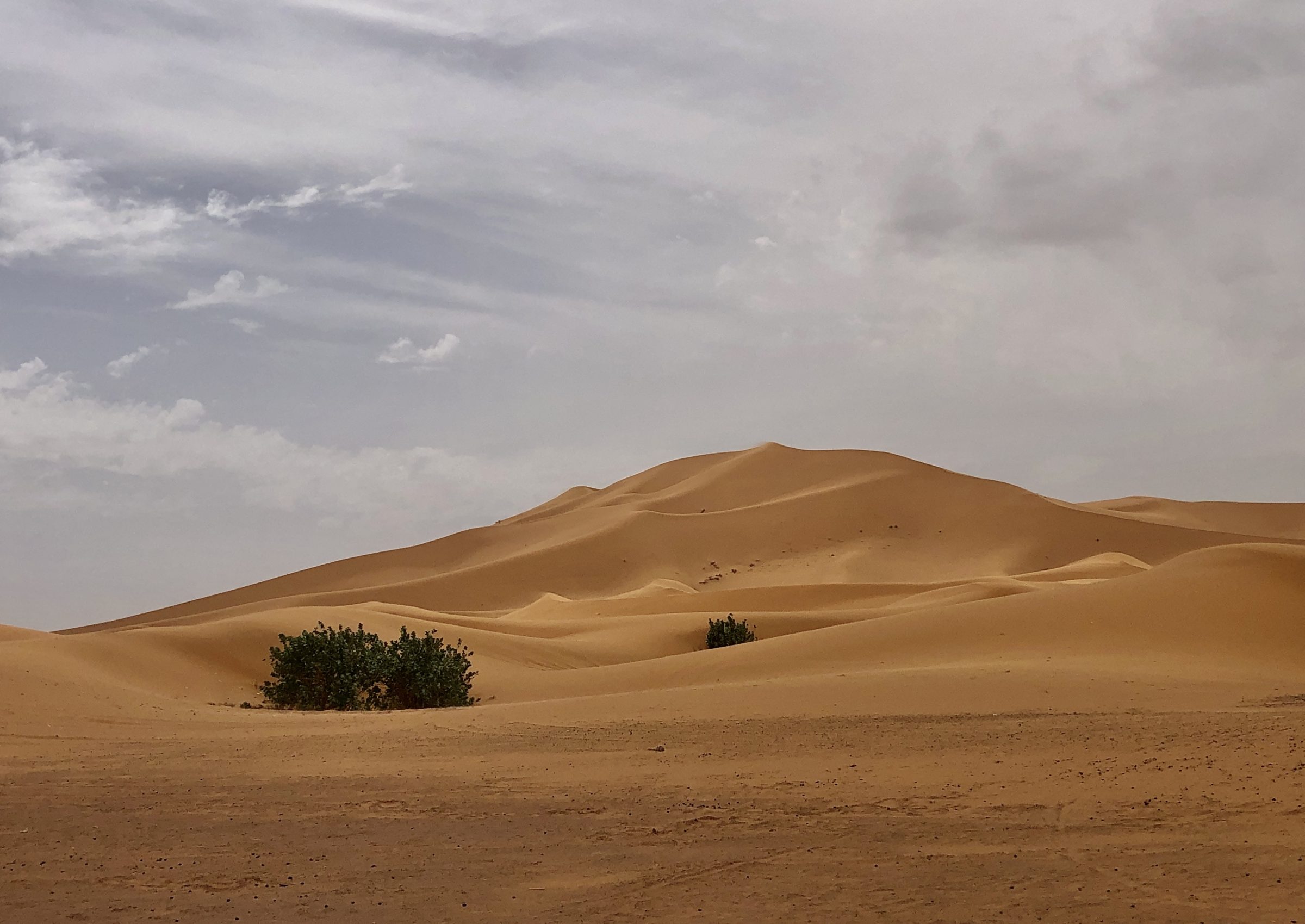
Merzouga and beyond
Then we drive on to Merzouga, the center of desert tourism. There are more 4×4 cars - mostly Landcruisers - driving around here than donkeys and horses. Incidentally, the 4×4s are supplemented with many dromedaries.
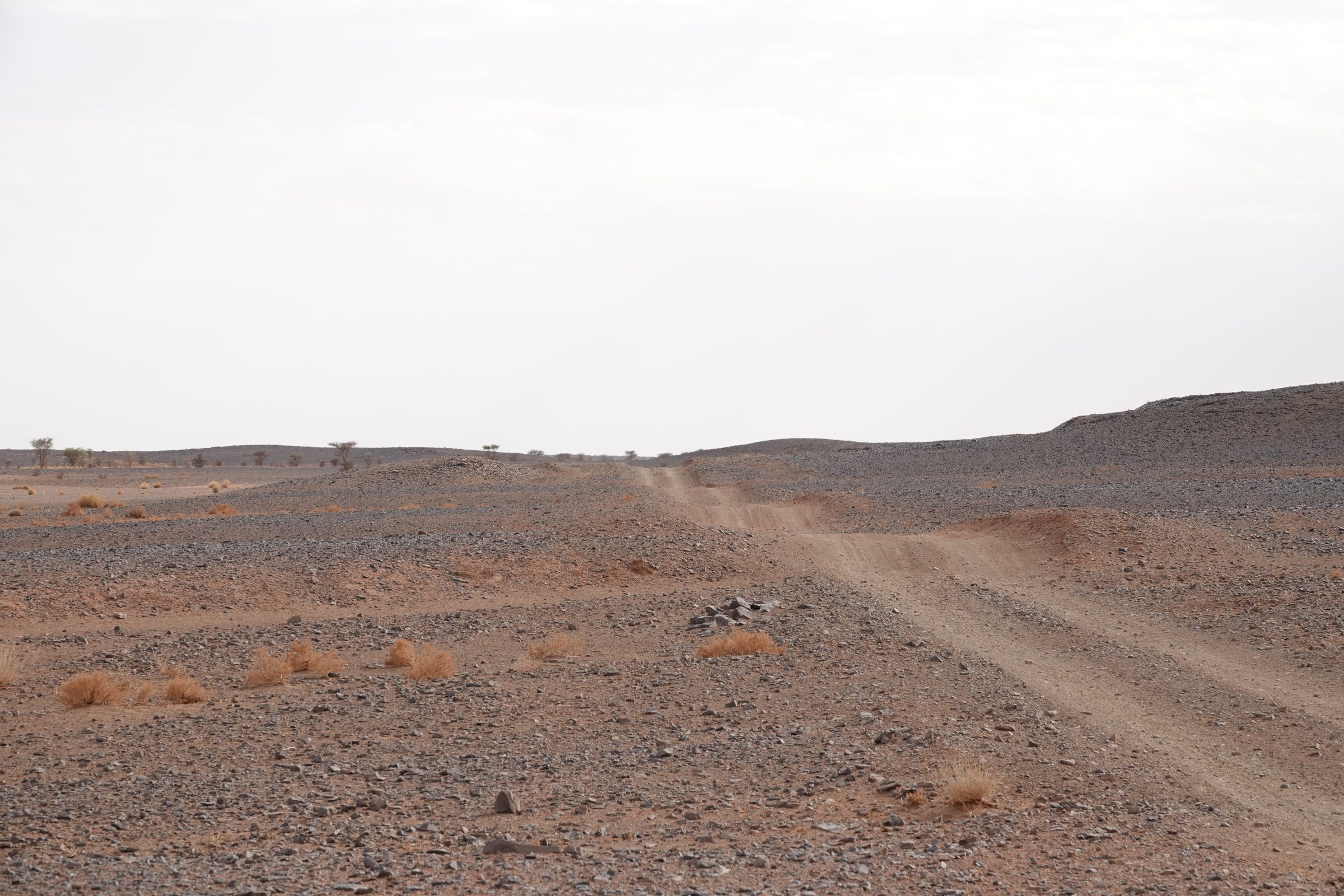
We do some shopping and buy a cup of coffee. You can tell from everything that people are after the wallets of Western tourists. That does not make the people friendlier and the authenticity is lost. The village is also suffering a lot from the lost tourism due to corona, and has not yet recovered.
Then we drive into the desert with Zagora as the provisional end point (location here), at about 260 kilometers. The challenges begin along the way. Deep potholes, high bumps, deep sand, stones and washboard roads, we come across it all. The car can handle it all without any problems, great!
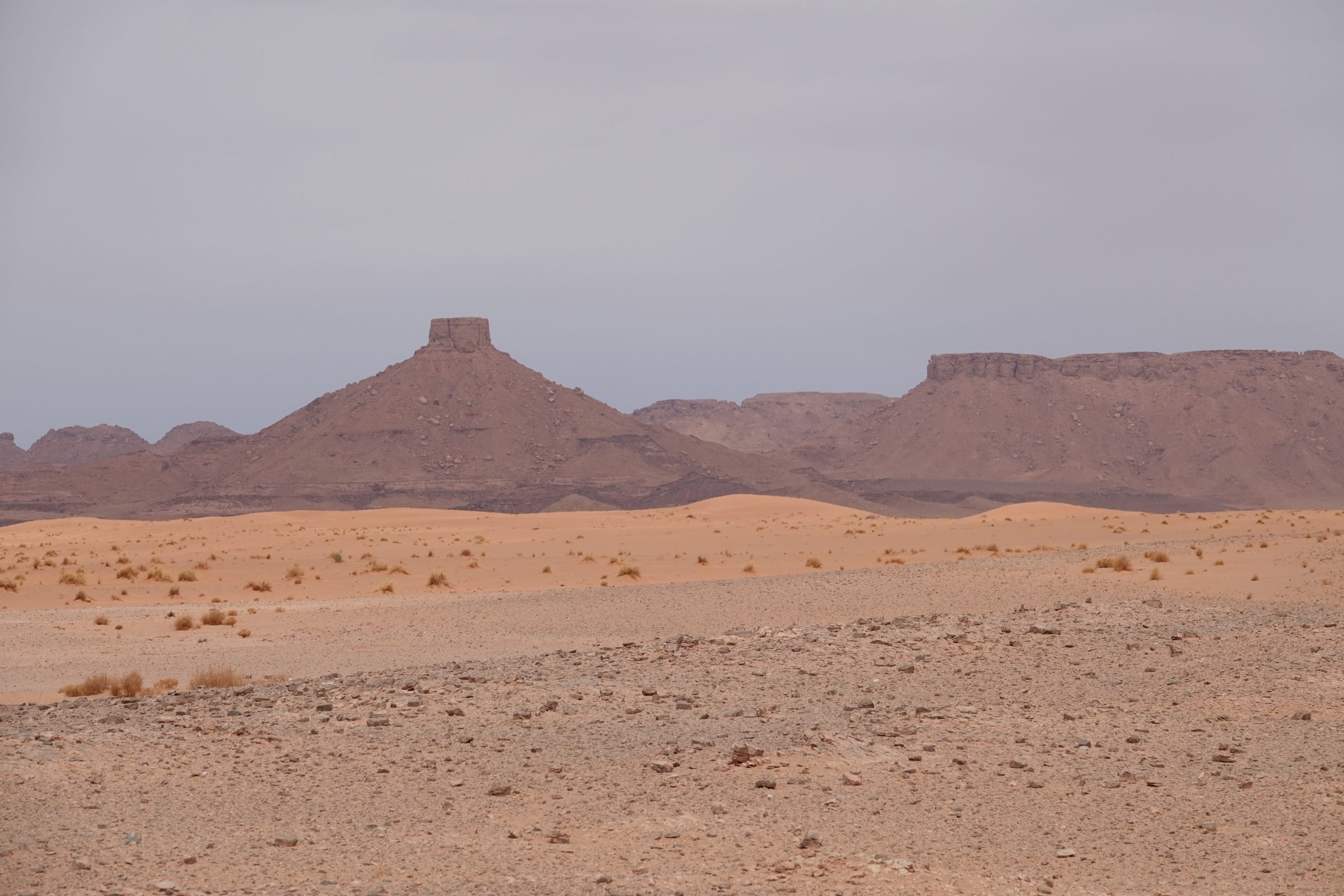
Many different landscapes pass us by, but the infinity is perhaps the most impressive. In the beginning we see a few nomad tents and sometimes an old-fashioned auberge that are often deserted.
Then there is another small village with dilapidated houses. Children run after us, hoping for a candy or something like that. Then back into the wide desert, often close to the Algerian border.
On to Tagounite
Our spot from last night can at least be in the top 10! Wow, what a view! In our 360 degree view we just look 20 kilometers around. No light, no signs of human activity. Are we on the moon?
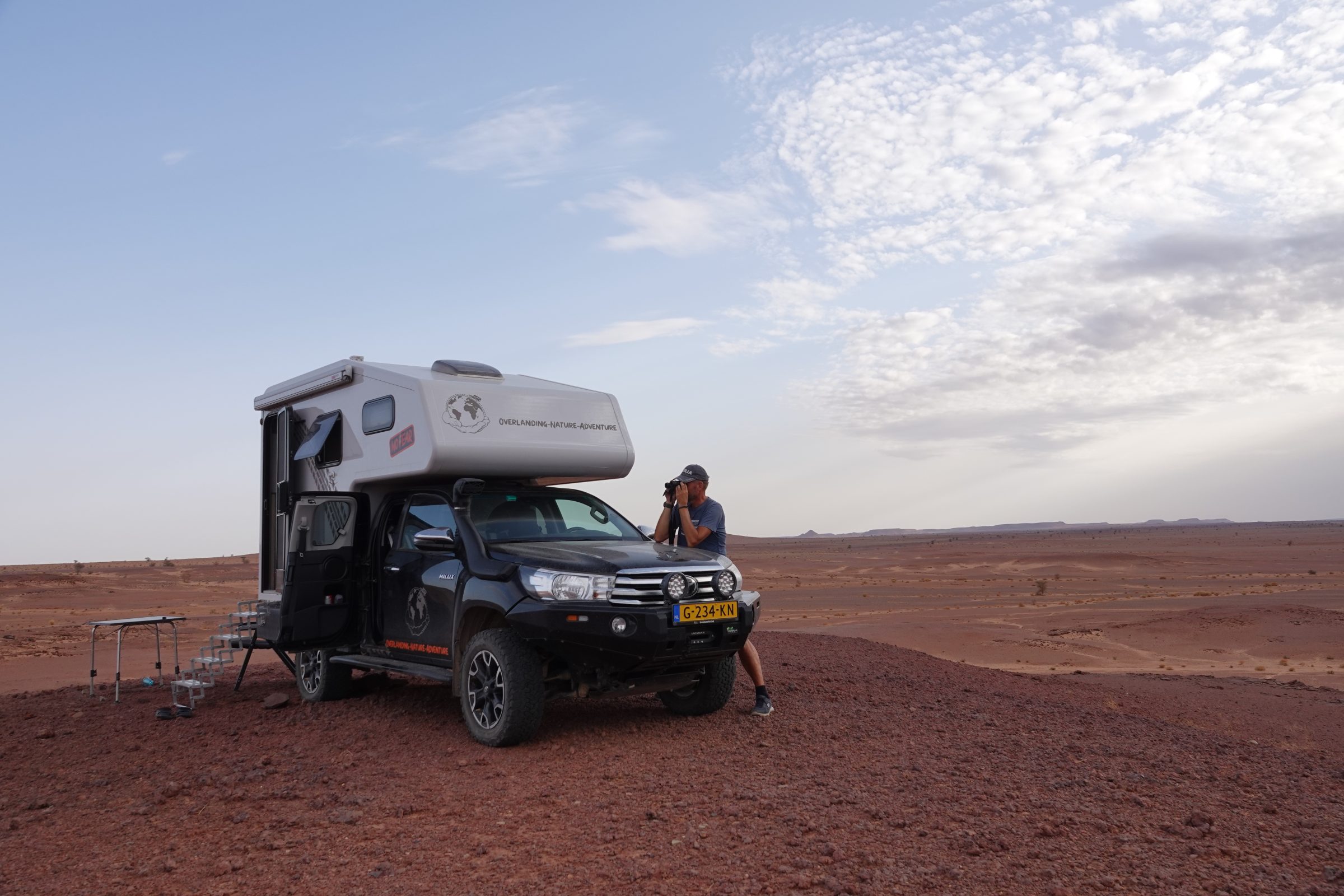
In the morning we drive down the mountain and continue our route towards Tagounite (location here). Initially a lot of stones on the route, not our favourite. Later we drive over a mountain ridge after which we have a fantastic view over the colorful landscape.
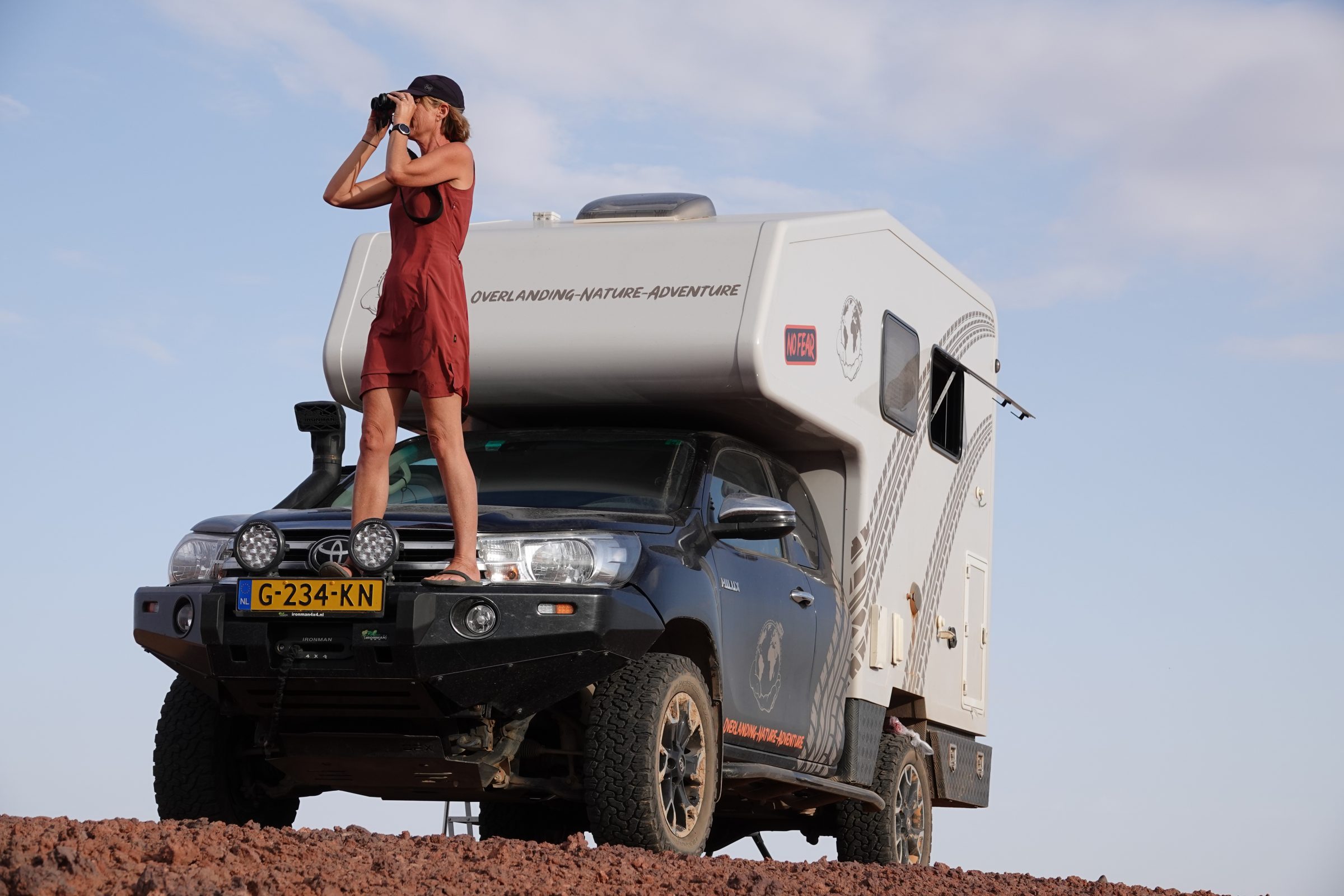
Then follows another part interspersed with sand and stones before we reach the oasis around Tagounite. It all looks quite modern and well-kept here. The youth, in particular, are very “in time”.
A boy joins us on a terrace where we have something to eat and drink. He talks spontaneously and enthusiastically about his life, wife, children, religion and traditions. It's a nice conversation.
Stuck on a sand dune
Then we go further into the desert. Only just on the way, Cor makes an error of judgment. The sand dune appears to be higher and sharper from above than estimated. On top of the hump we get stuck because the underside of the Toyota is firmly attached to the “ground”.
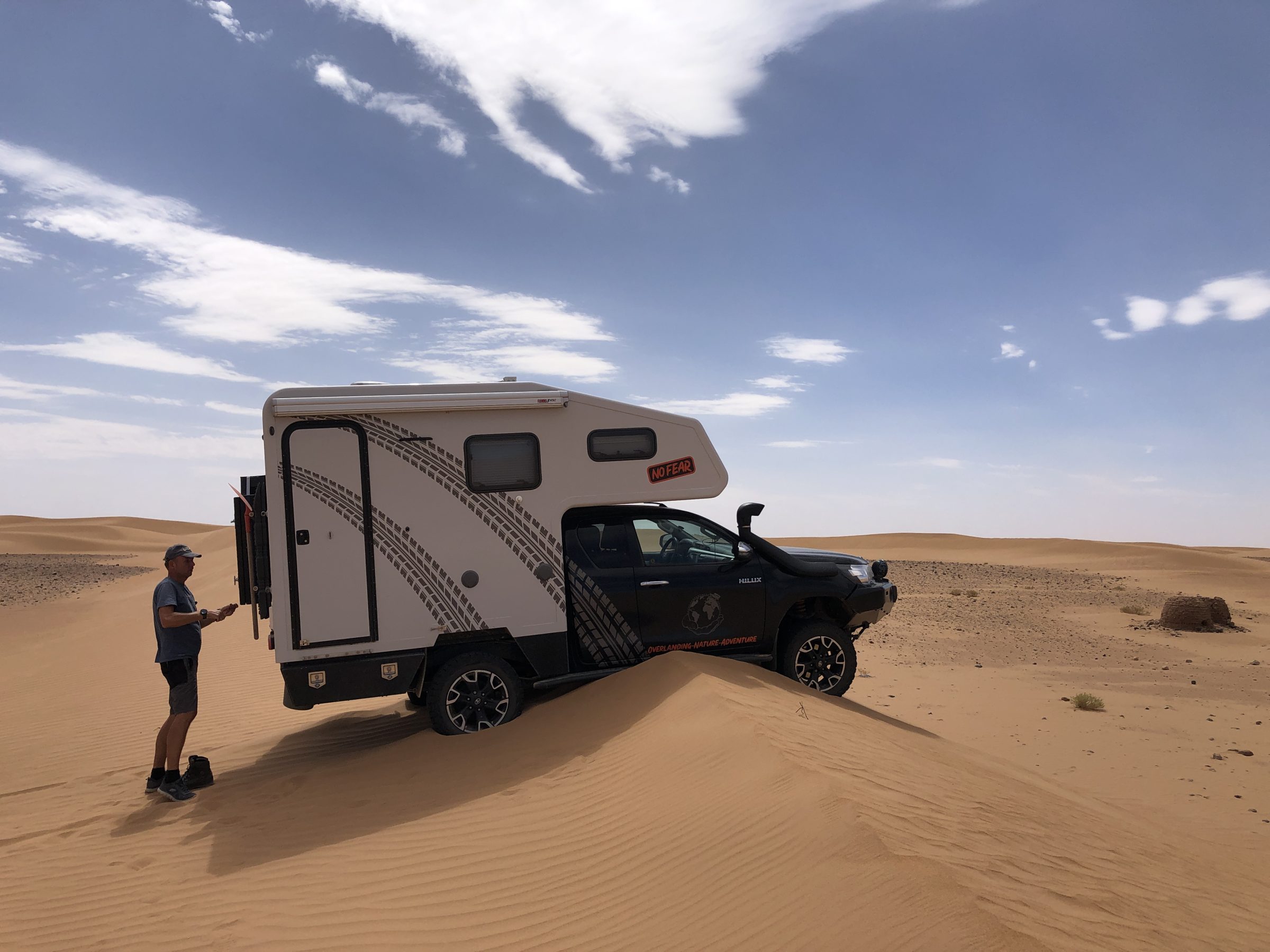
We start to shovel something, but that is not enough. A desert dweller approaches from afar and later a Landcruiser with three men. They all start to help. That's Morocco!
We try with the winch, but we pull the Landcruiser backwards instead of us forward. Then we jack up the car at the front with our inflatable jack and place the sandbanks under the wheels. That brings the solution.
In reverse, differential lock engaged and moments later we are back on a firmer surface. It was good teaching.
A strong wind at 43 degrees
Then further. We drive through so many different landscapes and it is so vast that we are sometimes silent.
The wind is blowing harder and harder and the temperature rises to 43 degrees. It feels like a blow dryer blowing in your face. Quite a challenge for man and machine. Because the sand has often swept away the tracks, we regularly have to search for the right direction. The many sand dunes make it an extra challenge.
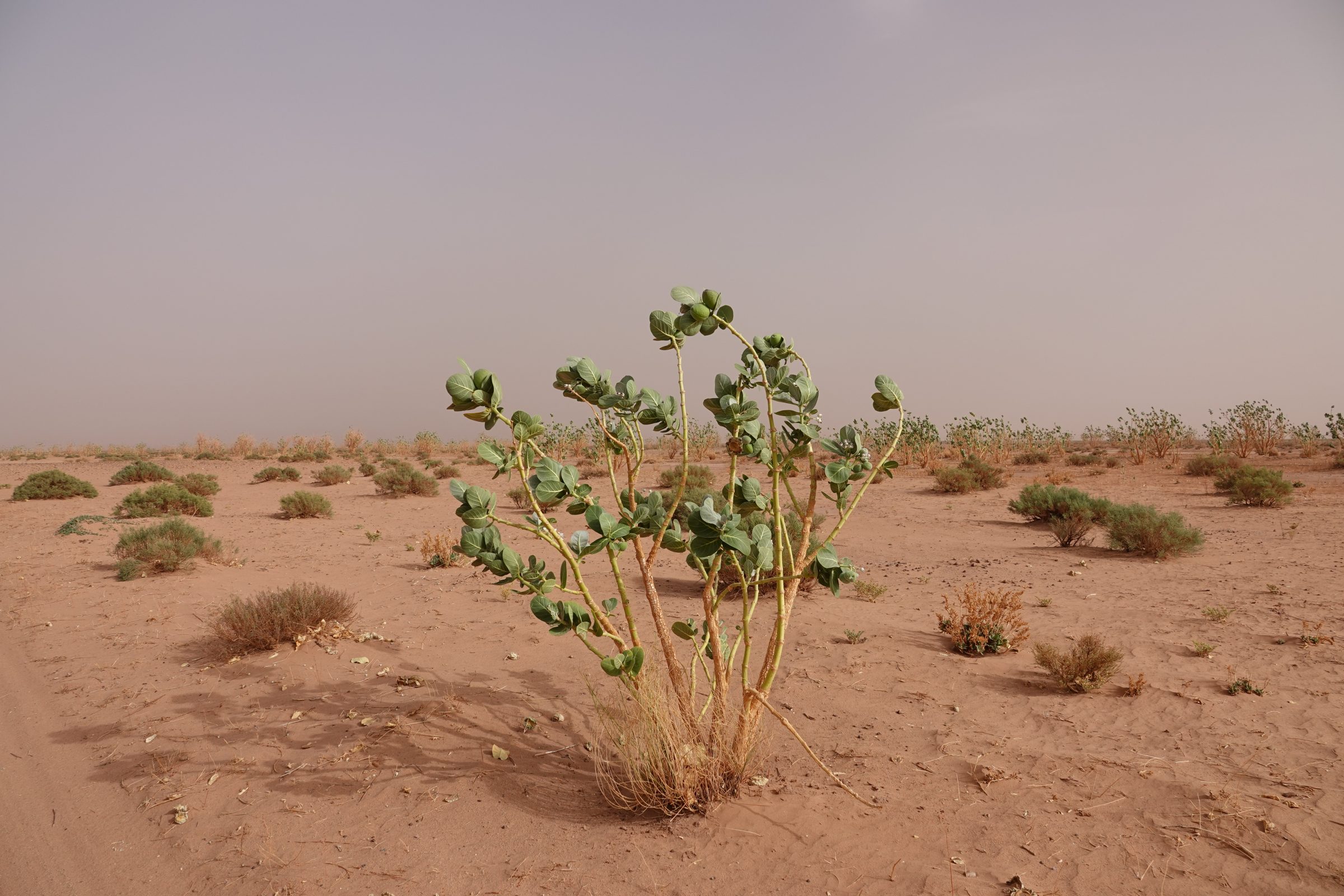
We are looking for a sheltered place to spend the night, but that is not easy. The wind is blowing hard, the air is gray with sand and dust. After a long search, a half-finished building suddenly appears. We will stand behind this, somewhat out of the wind.
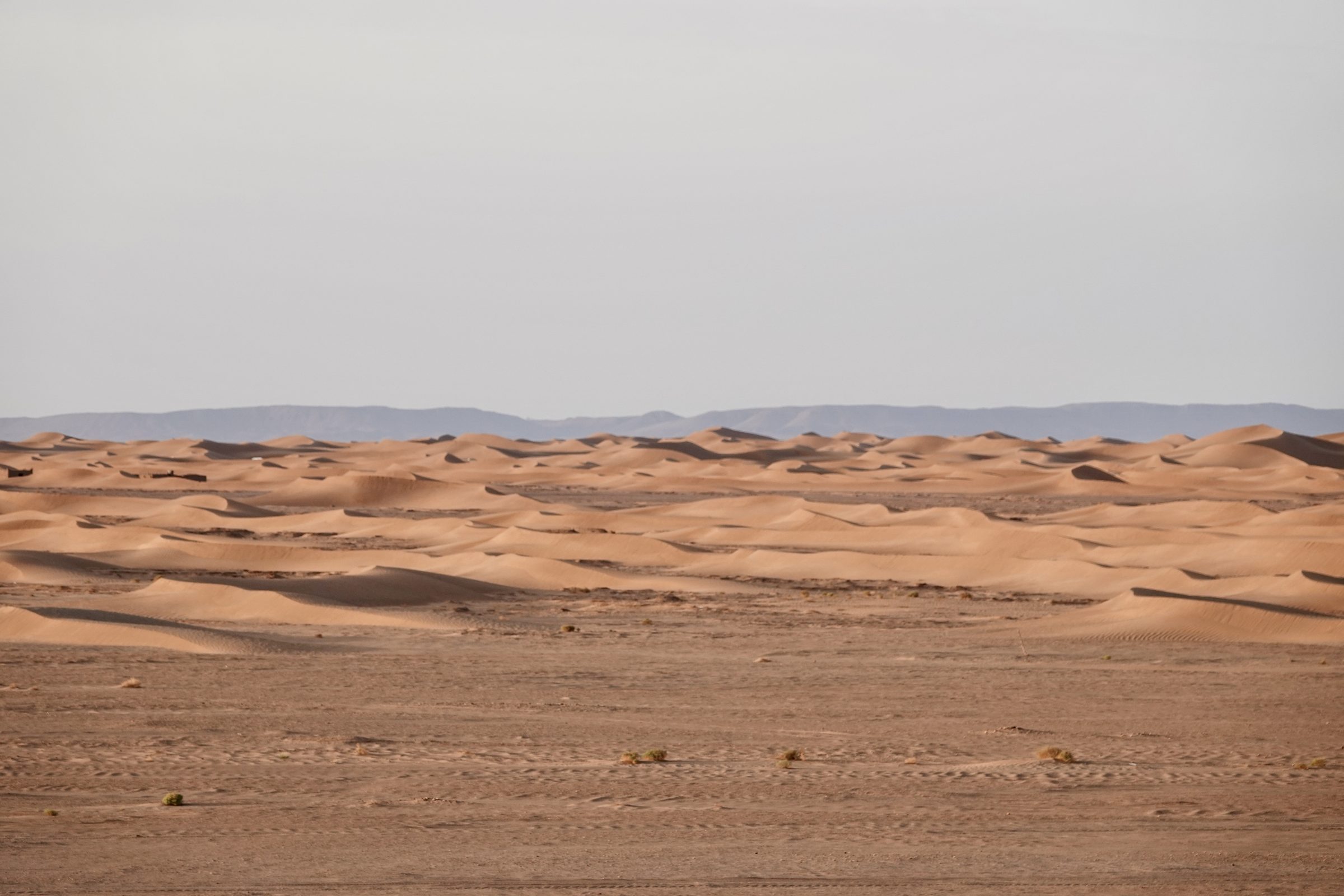
Everything is now full of sand. Every crack and seam of both the car and the superstructure is full of it. That's life in the desert…
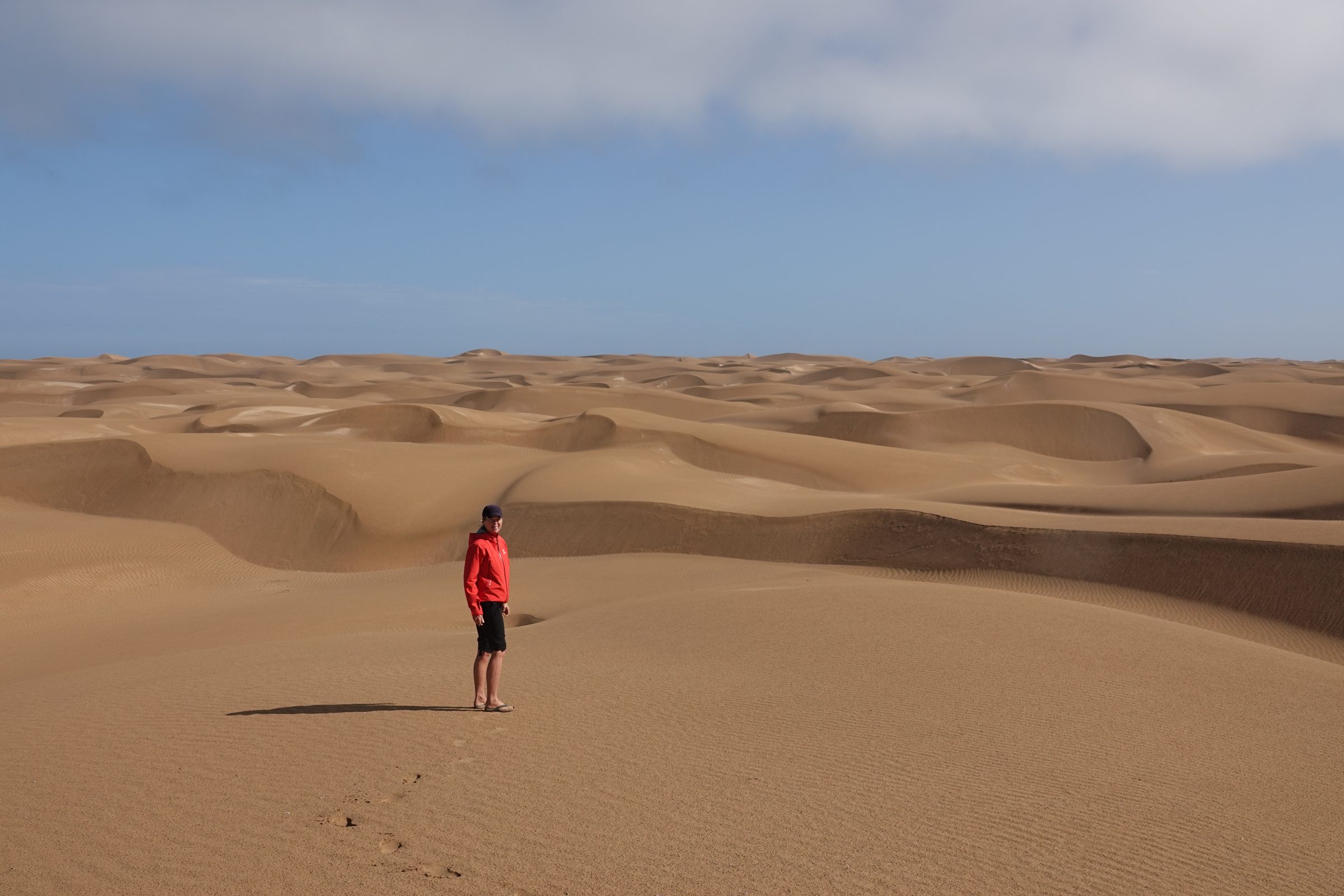
NP d'Irikic
The next day we leave for NP d'Irikic (Location here) with the associated dry lake, but first through sand dunes, a lot of sand dunes. The Toyota holds up perfectly and we enjoy it.
Then comes a long piece with a few Auberges. In one of them we drink a cup of coffee. We are also the only guests. We supply the milk ourselves for a café au lait. The manager says that the Paris-Dakar rally and Carta rally used to pass here.
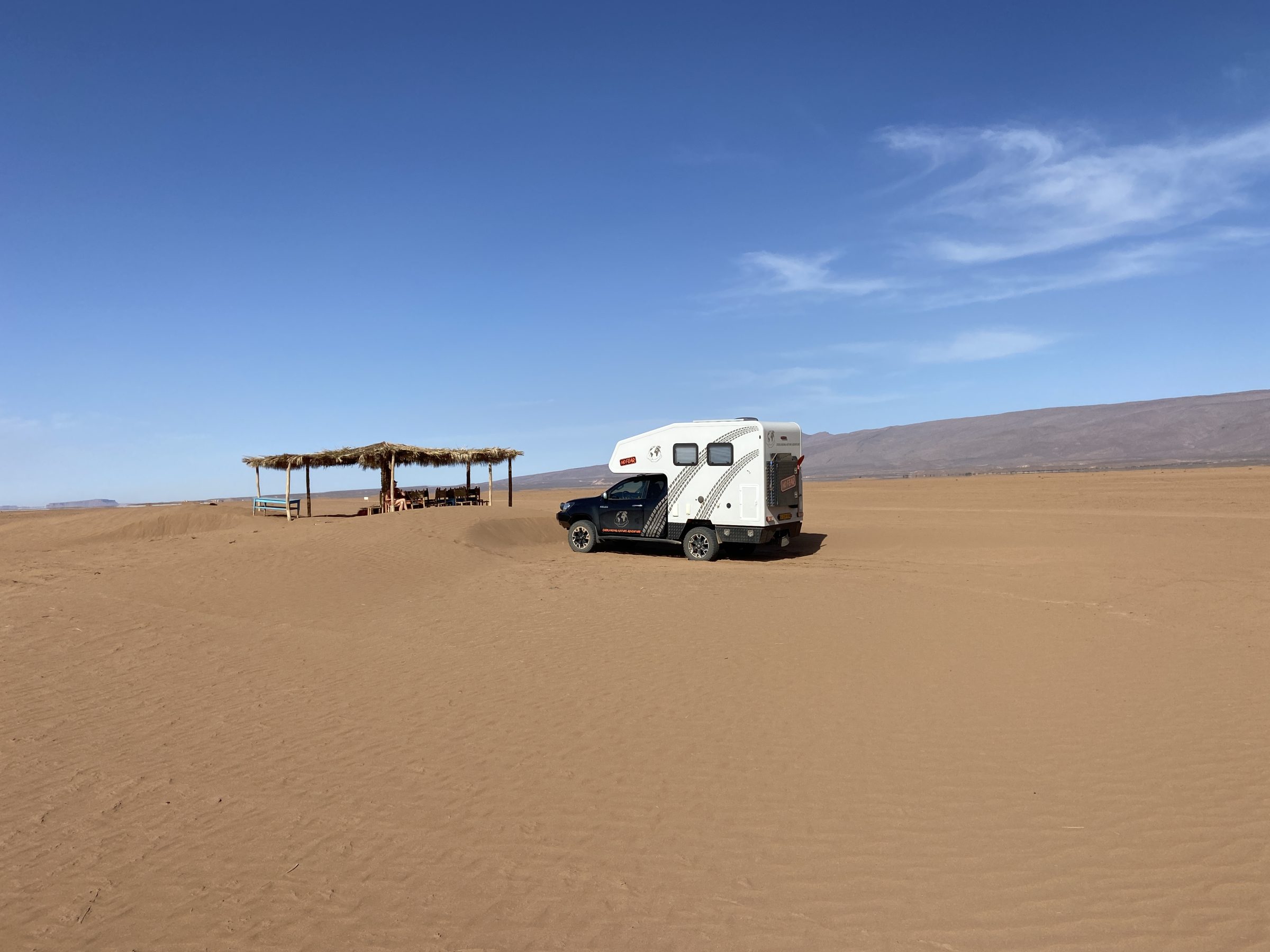
Then on to the lake, a huge dry loam plain where we sometimes reach speeds of 80 kilometers per hour. Great again.
After a long drive we reach Foum Gzuid (Location here), where we eat something.
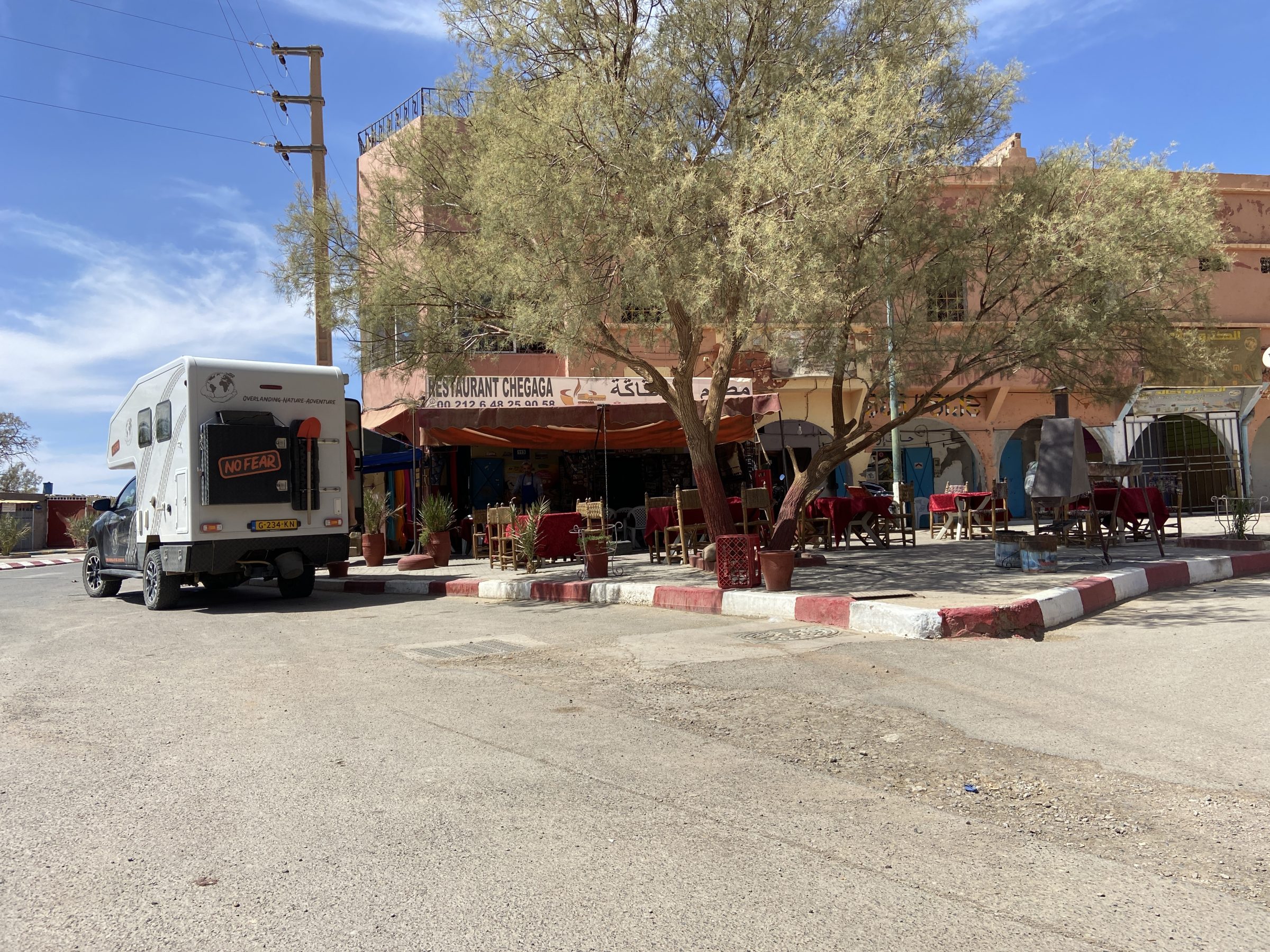
Difference Between North And South Morocco
The villages in the south often look more modern than in the north. People are also more progressive. The quietness on the street is also really striking. Large, wide streets, unlike the bustle in more northern villages. That actually started in Ouarzazate, and so south of the Atlas Mountains.
In the desert, the differences in living standards seem even greater. Here you see villages with wide streets, partly Western dressed people, associated shops, cafes and restaurants. Apparently they want to pamper the desert tourists while taking advantage of it themselves. But if you end up in the "back streets" or in the countryside, it is downright shabby. Clutter on the street, half-finished shacks and traditionally dressed people.
Tourism is at a low ebb. The facilities are there, but there are no people. After corona and the hot summer, it is now hoped that tourists will return in October. Inshallah!…if Allah wants it…
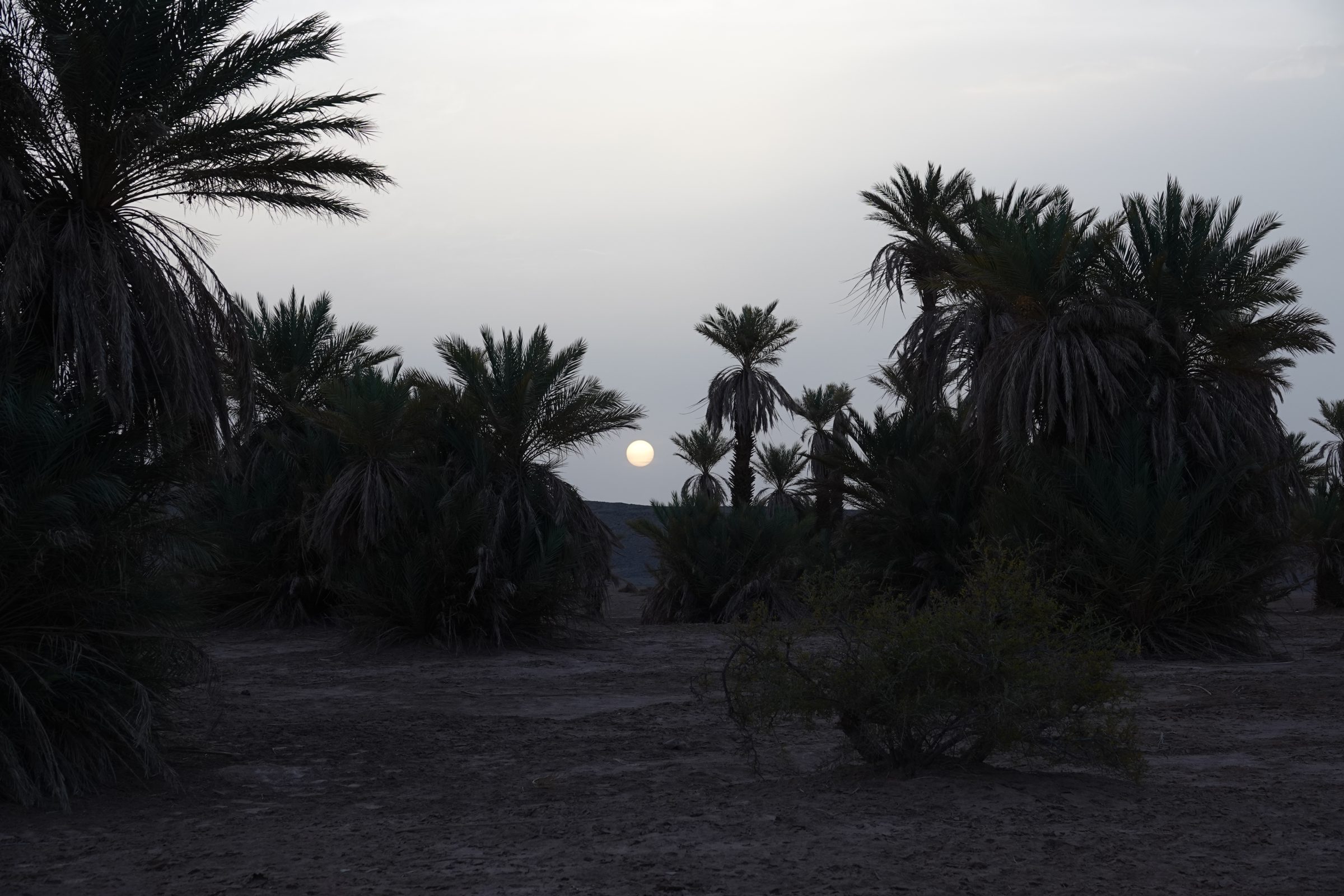
From Foum Gzuid we go back onto the asphalt in a south-westerly direction, we pick up speed for a while. The temperature is high again, 40+. Long live the air conditioner! We find a place in a palmerie just after Tizounini.
Dates
We thought we would once quietly “celebrate Sunday morning” in the palmerie, but a desert dweller comes out from behind a palm tree.
'Bonjour, ca va?', and a gesture to his mouth. We respectfully told him that we would like a little privacy.
We continue our way and come to a village called taghjijt (Location here). Here we see a lot of date palms. In the palmerie we see people busy at work. Maintenance of the trees, where they burn the sawn branches.
A boy comes up to us and gives us a handful of ripe dates. They are really delicious, fresh from the tree. He invites us to a booth a little further away where we can sit on a few cushions.
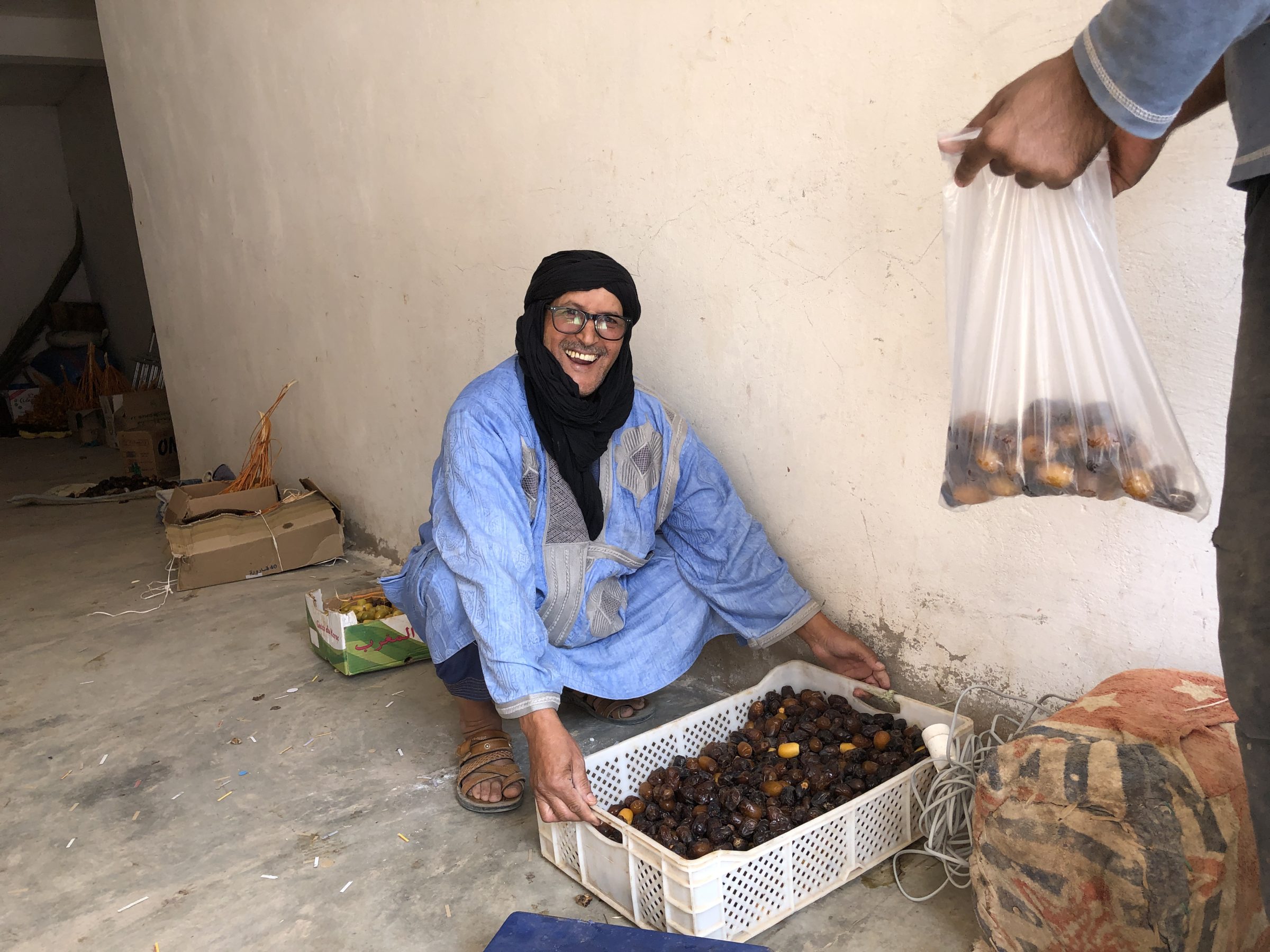
More dates and milk are coming. This combination is traditional, sometimes also with butter. Several workers come and sit with us and it is a lot of fun. Then we take another kilo of fresh dates and have another experience.
To the coast
We drive on and approach guelmim (Location here), the gateway to the Sahara, where we only drive through the enormously wide “Avenue”. Boy, what a modern city again, at least the main streets….
The weather is changing. We left this morning at 38 degrees… towards the coast it is barely 20 degrees, while it starts to rain lightly. Finally we reach the Atlantic Ocean, where a river (three times a year) flows into the sea.
We see many fishermen's houses along the delta and we talk to a boy who lives there. He speaks good English and talks about his life as a fisherman's son.
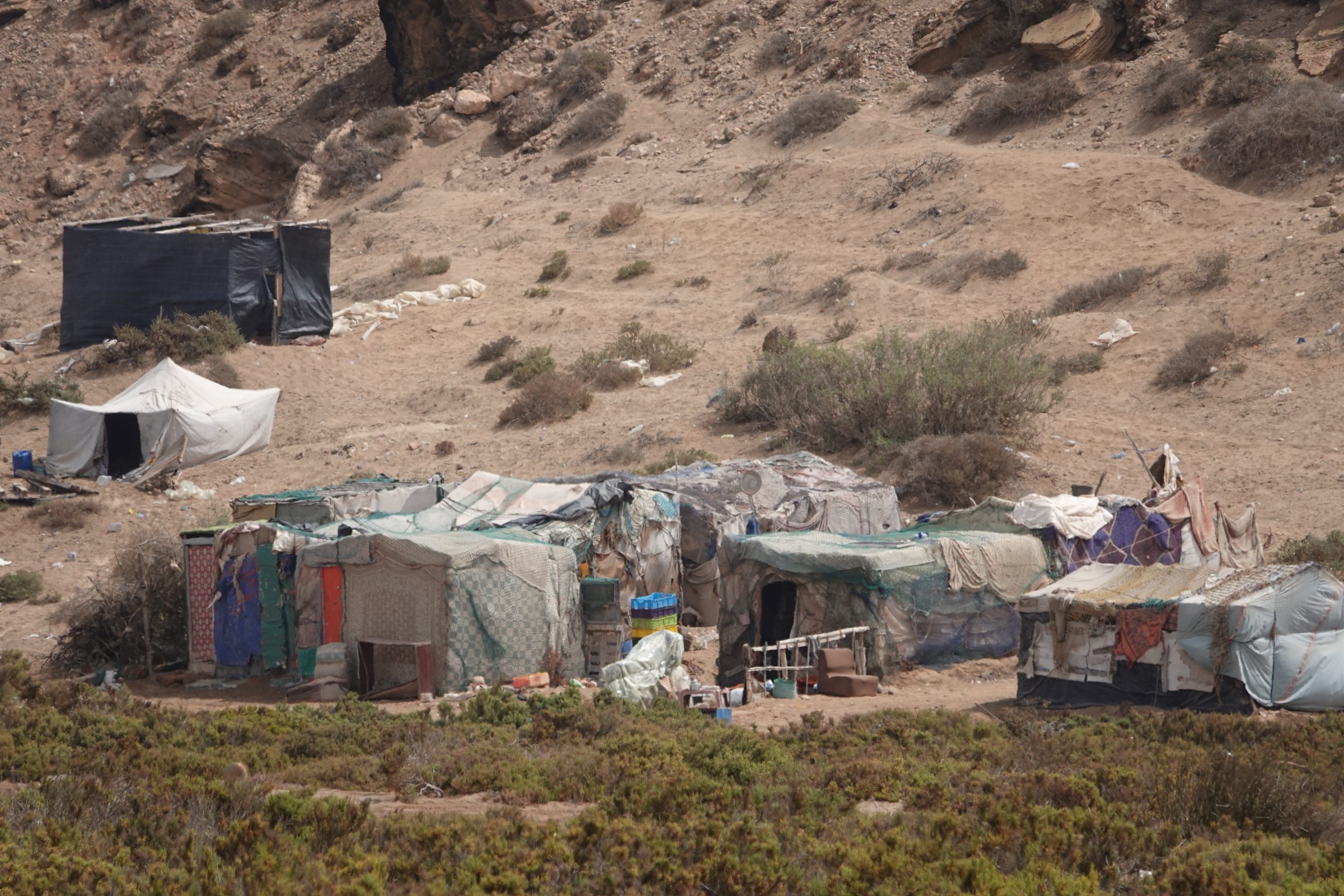
It is better to call the houses where people live in slums. They are in a beautiful natural environment that unfortunately has been spoiled by the huge piles of rubbish. The boy was born here and lives there with his father and mother. Father is a fisherman and once in a while a buyer comes to take the fish. This is then sold in the larger towns. A little further on is a building where the boy, together with other fishermen's children, went to school.
Khnifiss National Park and spotting flamingos
We descend further south and come to Khnifiss National Park (Location here), a large delta area where many, many species of birds reside against the backdrop of highly inflated dunes and salt marshes. A beautiful nature reserve and mecca for bird lovers.
We find a spot near a jetty and some slums where fishermen hang out. We soon get to chat with some fishermen and are invited to tea. Their wives live in the villages further on, so that only men live here.
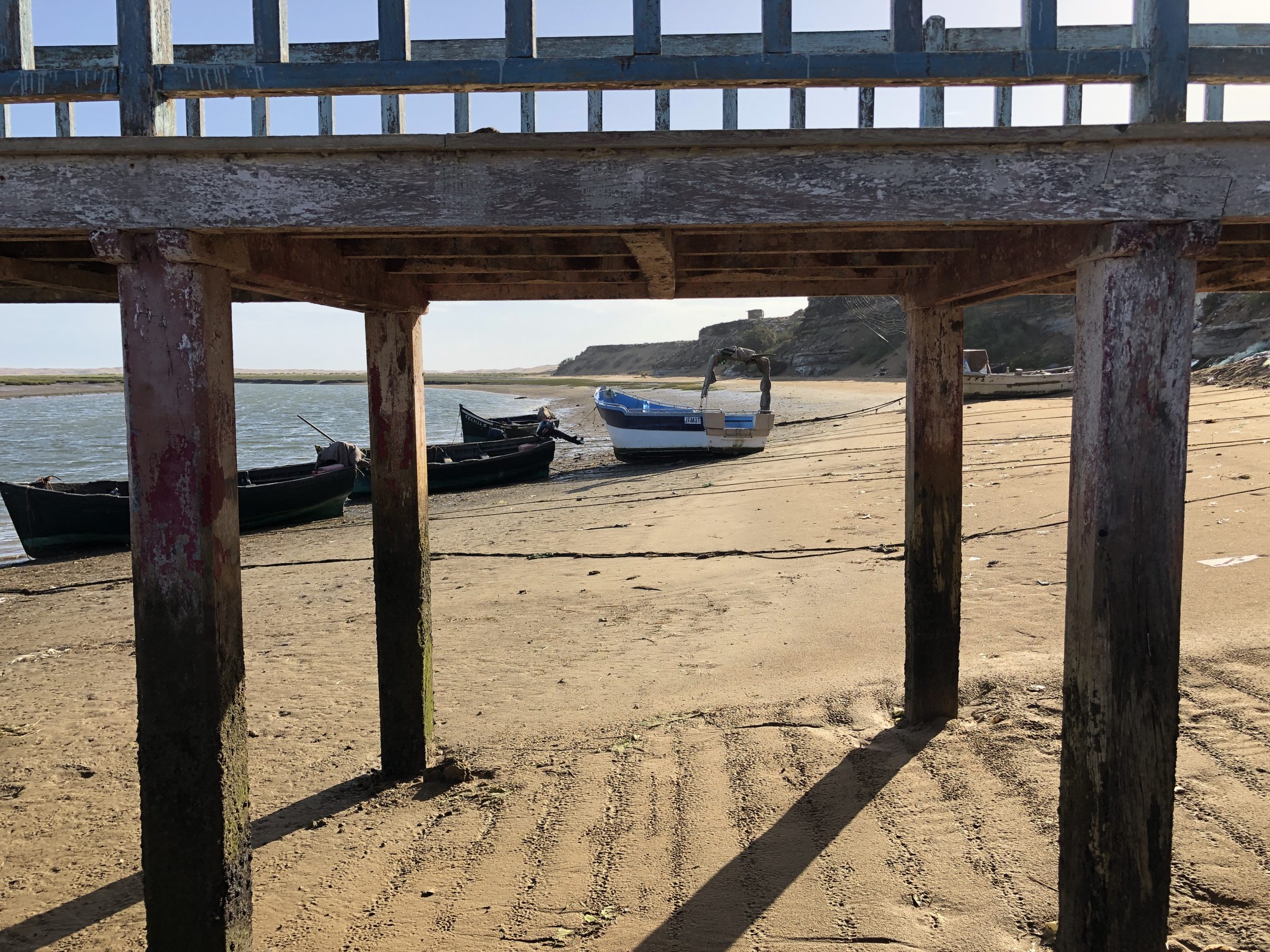
The next morning the fishermen stroll around the jetty, but they don't go out on the water. They say there is too much current on the high seas. That gives us an idea… would anyone want to sail with us in the delta area? We take the plunge and ask one of the men. He immediately says “yes”, and a little later we are sitting next to him in a fishing boat for next to nothing.
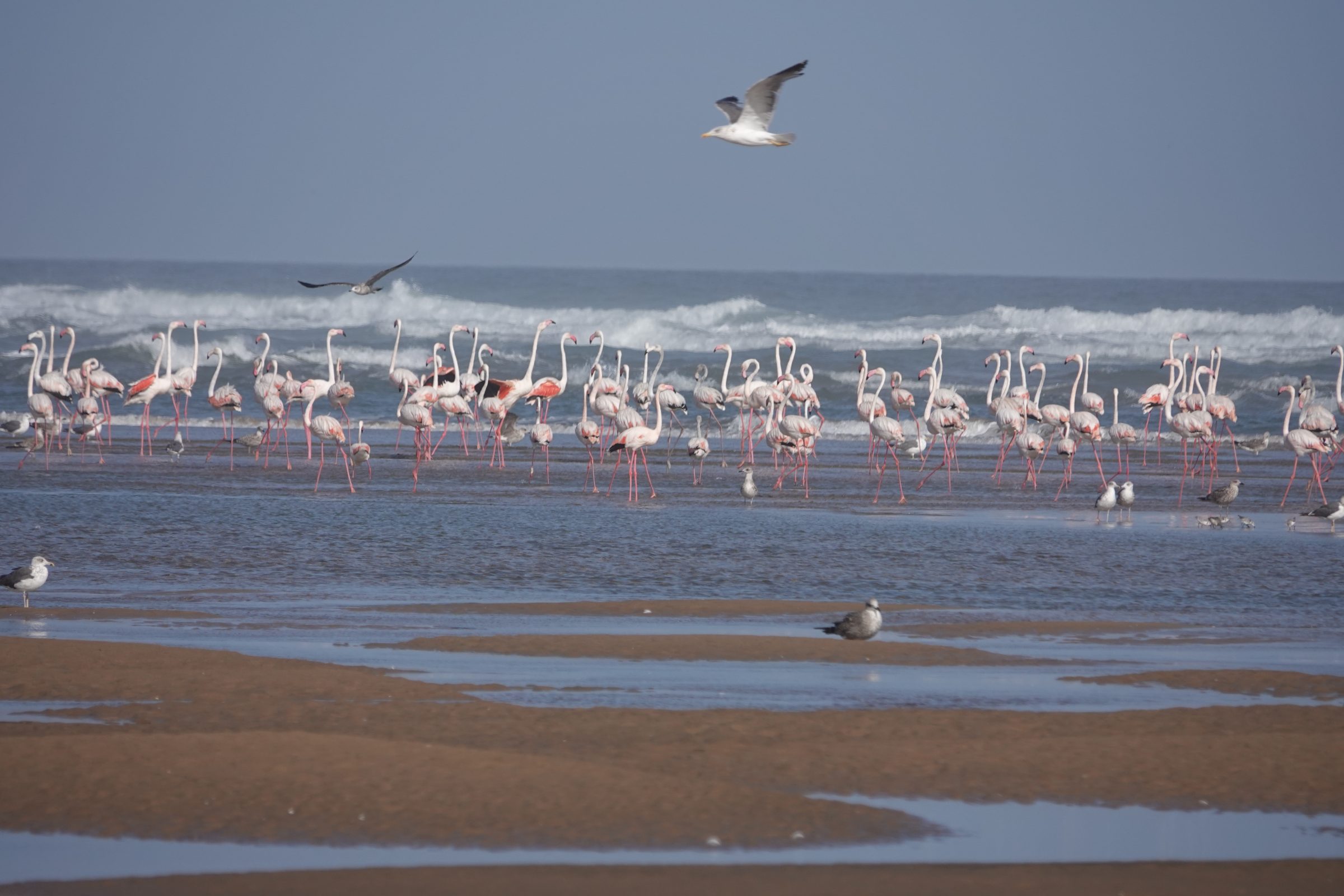
We sail along the sandbanks while the tide is out. We see many different birds and in the distance the blown up dunes. Then we go a little more to the part where the connection with the open sea is. Many hundreds of flamingos reside here. The large birds are standing on a sandbank where we moor. Walking we come a little closer. A beautiful sight and of course we are busy taking pictures. Then the fisherman claps his hands and the whole group takes to the air. A phenomenal sight.
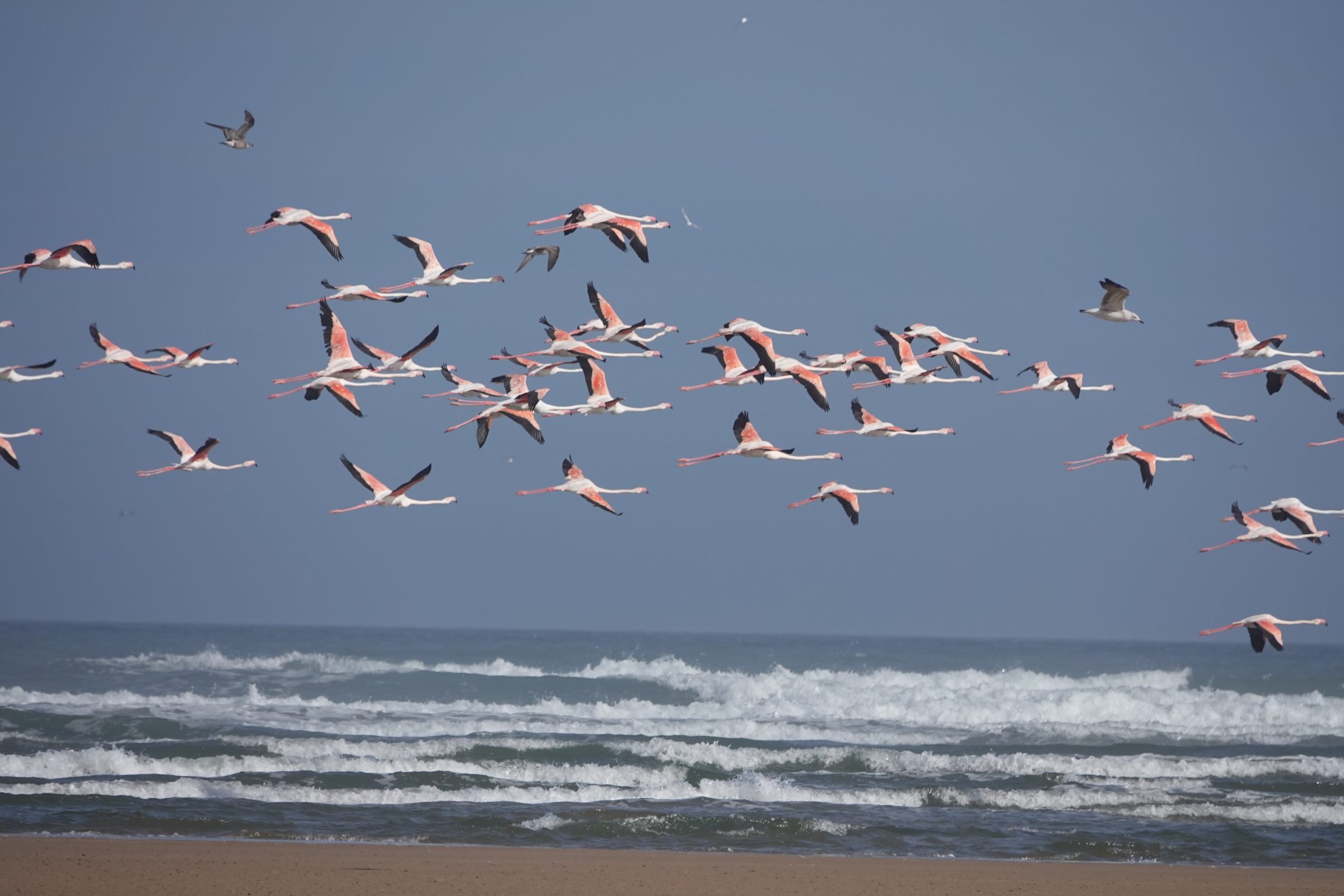
We go back to the boat and sail to a side where there are high sand dunes. We climb on it and have a nice view over the delta. This is so much fun!
Gradually we sail on and meet the group of flamingos again. The same ritual repeats itself. Then we go a bit along the steep cliffs and come back to the jetty. We can't believe our luck!
Control
Further south we are looking for a place to stay. It is not easy because we like to be out of the wind. No trees grow on the large bare sand plains, so we arrive at a village. We find a place in the middle of the village square, next to a small building and a mosque. We take the loud calls of the Imam into the bargain and will put some earplugs in our ears tonight.
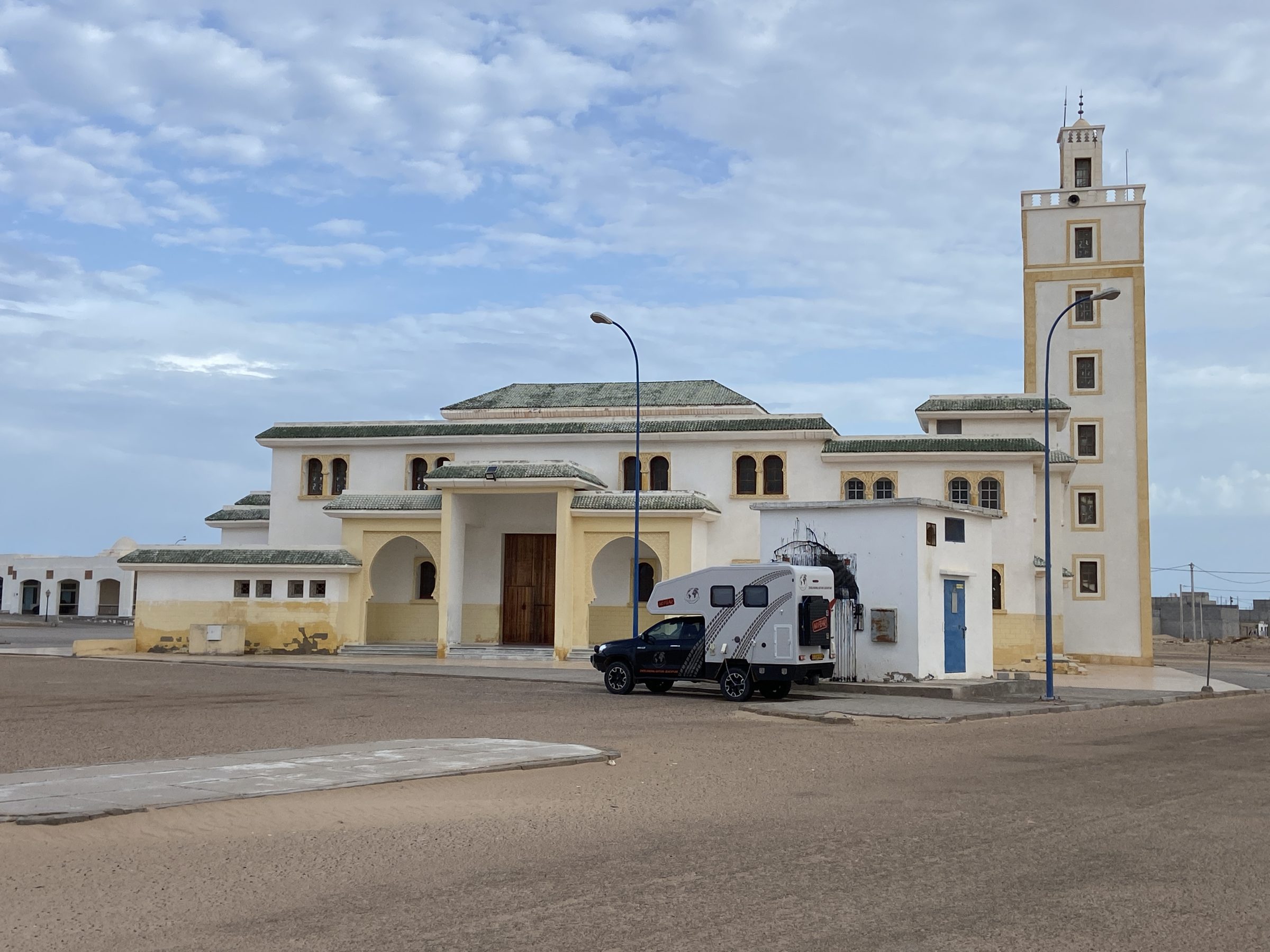
Immediately a village chief and a soldier arrive. The soldier would like a photo of our passports and the village chief often tells us how welcome we are.
Later in the evening - when it is pitch dark - a car with flashing lights comes from afar. What is going on…? Finally it stops right next to us. It turns out to be a police car. "What have we done"?
An extremely friendly agent comes out who again welcomes us and tells us where the village chief lives, in case there is anything wrong. He also gives us the (emergency) number in case we need it. After a “bonne nuit” he disappears into the dark again.
Dakhla
We still have about 500 kilometers to go on the perfectly asphalted road through Western Sahara. Western Sahara is a piece of land controlled by Morocco, they consider it the southern province. Not everyone agrees. Polisario, the separatist movement, supported by neighboring Algeria, wants independence. Fortunately, there is a cease-fire and it still feels like Morocco to us.
Dakhla (Location here) is located at the end of a peninsula of about 50 kilometers. At the beginning of the peninsula, the lagoon is a paradise for kite surfers. Modern hotels have been built around the lagoon, which are home to thousands of kite surfers.
Another 40 kilometers further is Dakhla. The only wide avenue leading to it amazes us. There are hundreds of half-finished hotel complexes, which you can see that they would become very modern. But the money was gone and partly because of corona no more tourists came. A sad face.
Dakhla itself is a modern city by Moroccan standards. We drove around and shopped. The people are very diverse, both progressive and traditional.
Special meeting
On the outside of Dahkla we find a spot along a boulevard under construction. Suddenly the car stops and two enthusiastic people get out. They absolutely love our 4×4 camper and ask if they can take a look inside. Hospitable as we are, that is of course no problem at all. We tell them we are on our way to South Africa and they are delighted.
They invite us to go to a restaurant next door to drink tea and smoke water pipe. Nice!
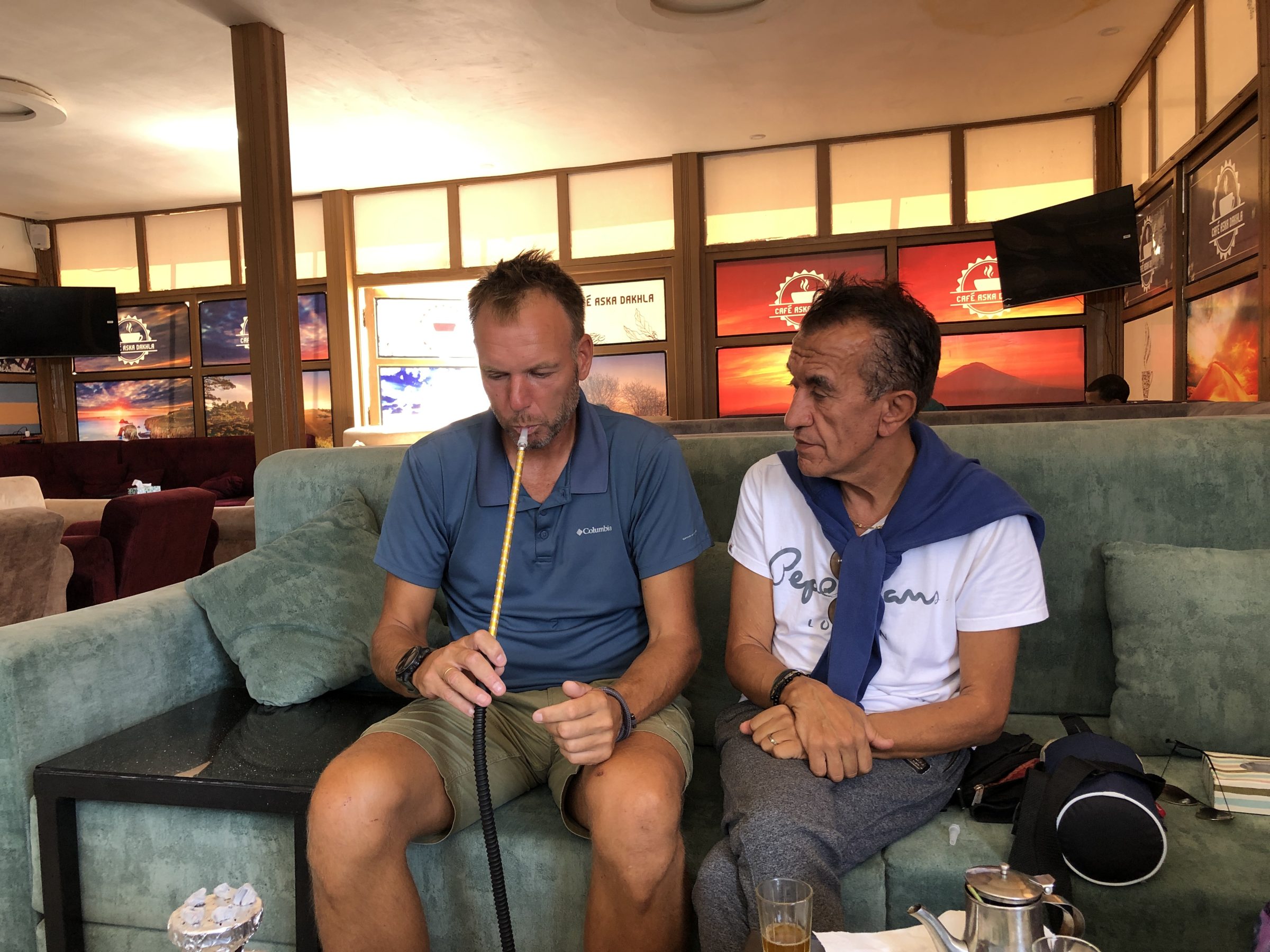
He was born fairly wealthy Moroccan and moved to France years ago where he met his French wife (Isabelle). Once in a while they are in Morocco and they are now building a small apartment in Dakhla.
After the visit to the restaurant where we both get acquainted with the water pipe, they take us through Dakhla. While talking they invite us to join us for dinner in a Senegalese restaurant, because they have heard that we also go to Senegal to go.
He (Dalil) is a flamboyant type that everyone knows and so we end up at a Senegalese restaurant and eat a typical Senegalese dish. Something with rice and fish.
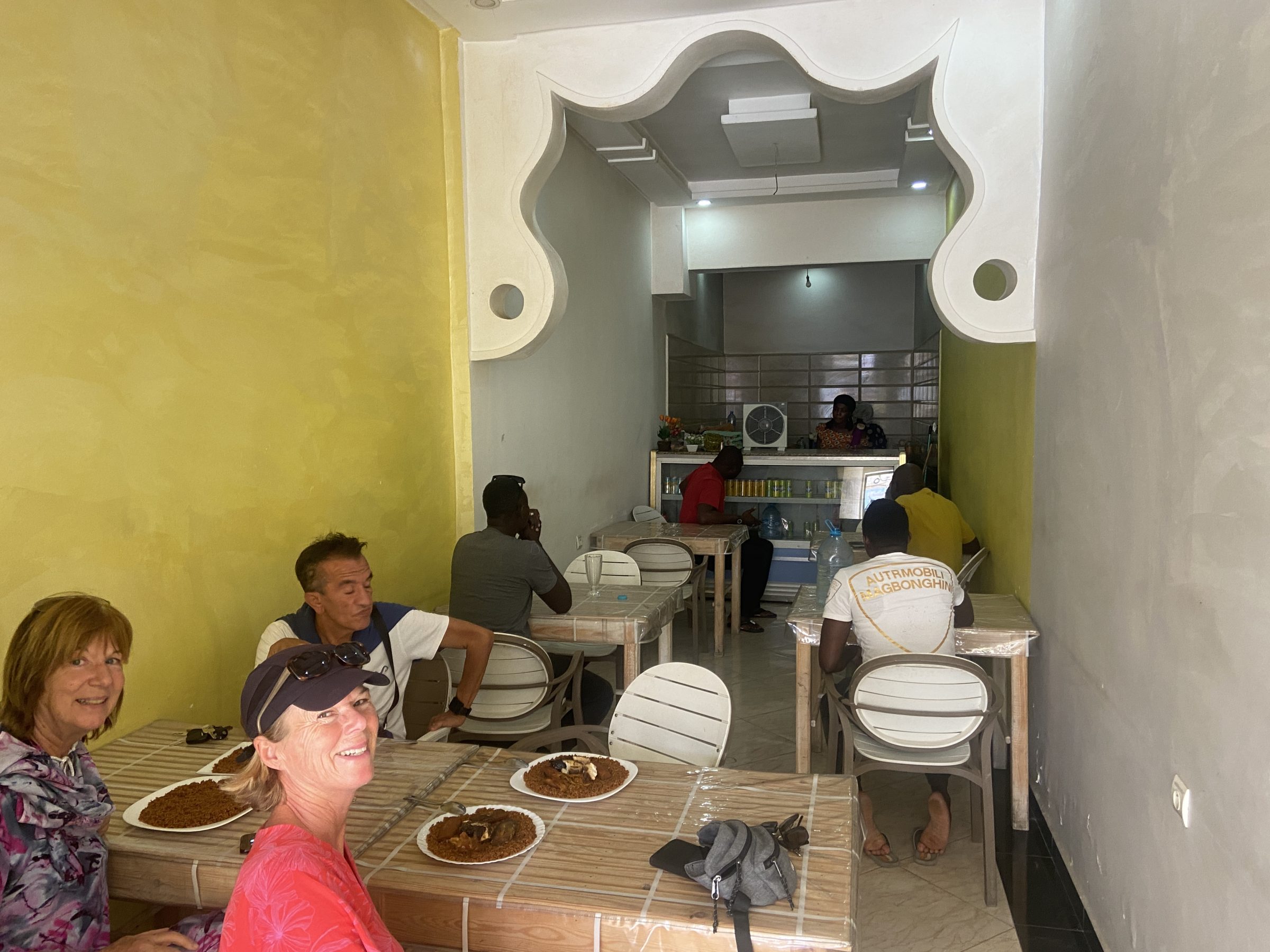
Gretel is still looking for a good hairdresser, Dalil knows one, and calls right away. There is still room and we can go immediately. It is a men's and women's hairdresser. But according to tradition, women are cut in a separate room and only by the boss himself.
Selma and Dabia
Later we go a little further to a shop where the owner is sitting on the floor drinking tea. Dalil comes there more often for fun and to relax.
We sit down on a rug and after a while get “the best tea in southern Morocco”. There are a few more people and stories are told about life in Morocco. Selma, the owner is a fat woman who has not moved. She only makes tea.
Sella is very religious and by 5 o'clock she has to pray for the third time this day. As we sit stiffly next to her, she begins to recite her verses and kneels forward.
Then Dabia, a friend of Selma's, enters. A very present type with the greatest stories. She takes it less precisely with the traditions and says that she has been married six (!) times. The cozier it gets, the further her headscarf sinks.
Then the idea arises to eat dromedary meat together tomorrow. Selma has a nomad tent far outside the city that she only uses in her spare time.
We make an appointment for the next day at nine o'clock at the market to do some shopping.
Camel meat with sand in the tent
At 9 o'clock we meet at the covered market and get fruit and vegetables. It is wonderful to walk through the city together with local people. Next to the fruit and vegetables is the fish department with many stalls. At one of them we chat with the salesman who is just starting to fillet a huge fish.
There are of course also many butchers, but a little further we go to a special butcher that specializes in camel meat. (Actually, dromedary meat, one hump) A new shipment has just arrived with huge chunks of the animal. Dabia knows exactly what she wants. The hump of the dromedary seems to be the most special, as well as the liver. We take everything with us.
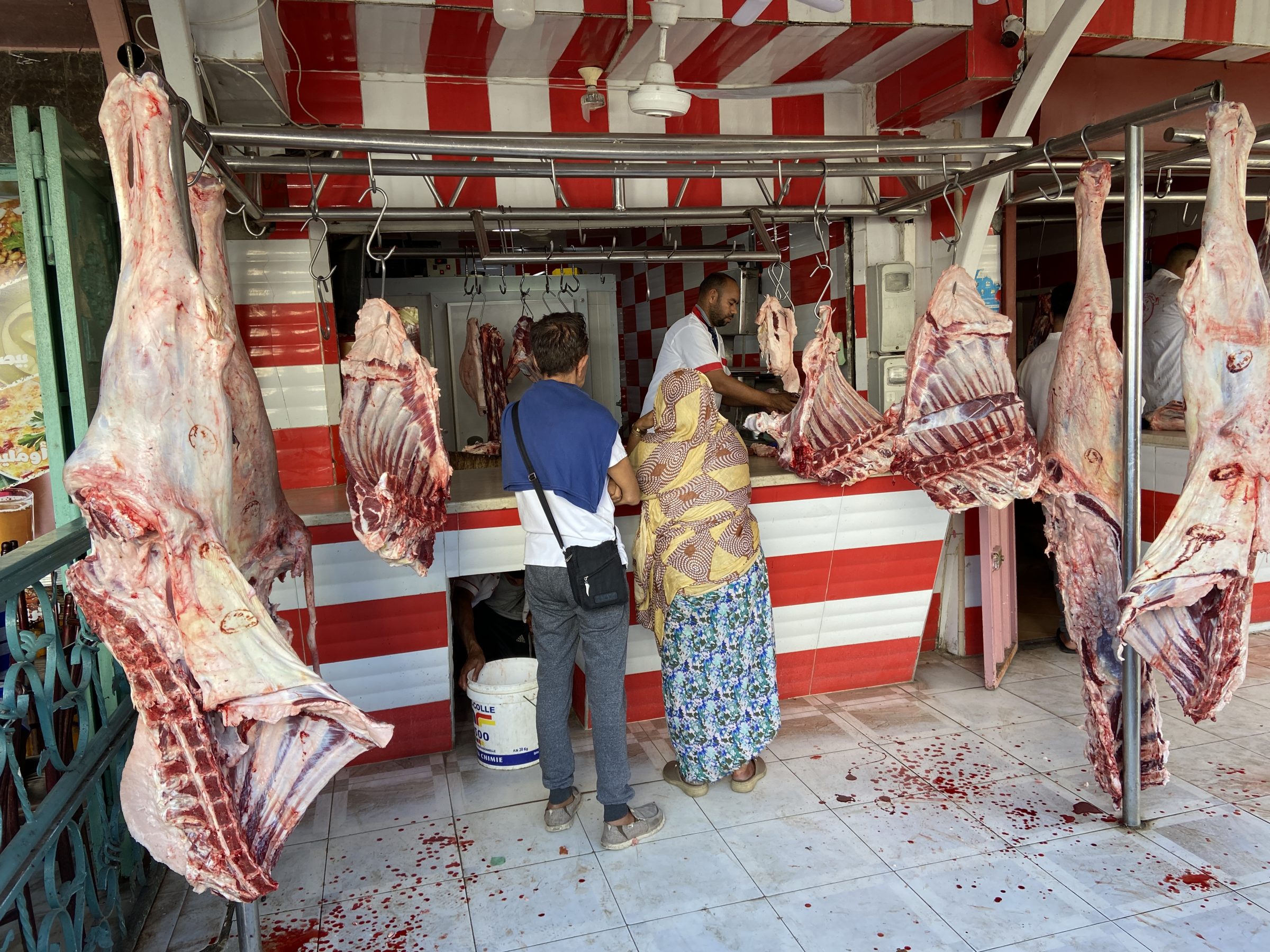
Then we go to the tent. This turns out to be about 40 kilometers outside the city and is actually a kind of leisure accommodation for Selma and her family. It is quite primitive but we can sit on rugs and cushions.
Dabia is busy preparing the meal. She cuts the meat, threads it on skewers and puts it on some kind of BBQ.
A little later we enjoy the meat. It has a neutral taste and in our opinion is not exceptionally tasty or dirty.
Selma spends the whole afternoon making traditional tea, her specialty.
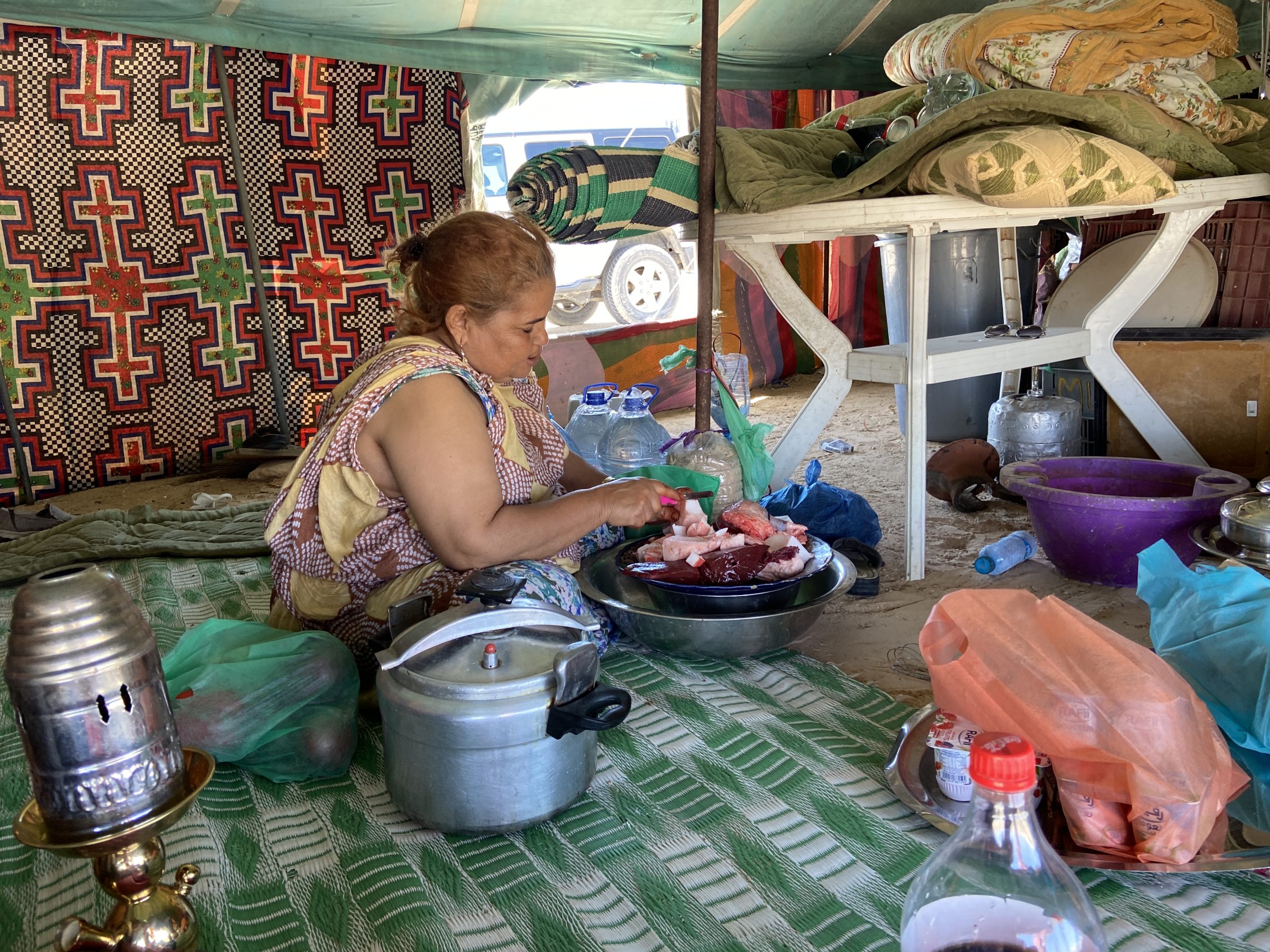
Dabia starts by making a large saucer. Rice in broth, with boiled dromedary meat. We sit in a circle and all eat from the bowl. Dabia likes traditional and eats with her hands. The saucer is anything but free of sand. The strong desert wind howls around the tent and the sand also swirls around in the tent to your heart's content.
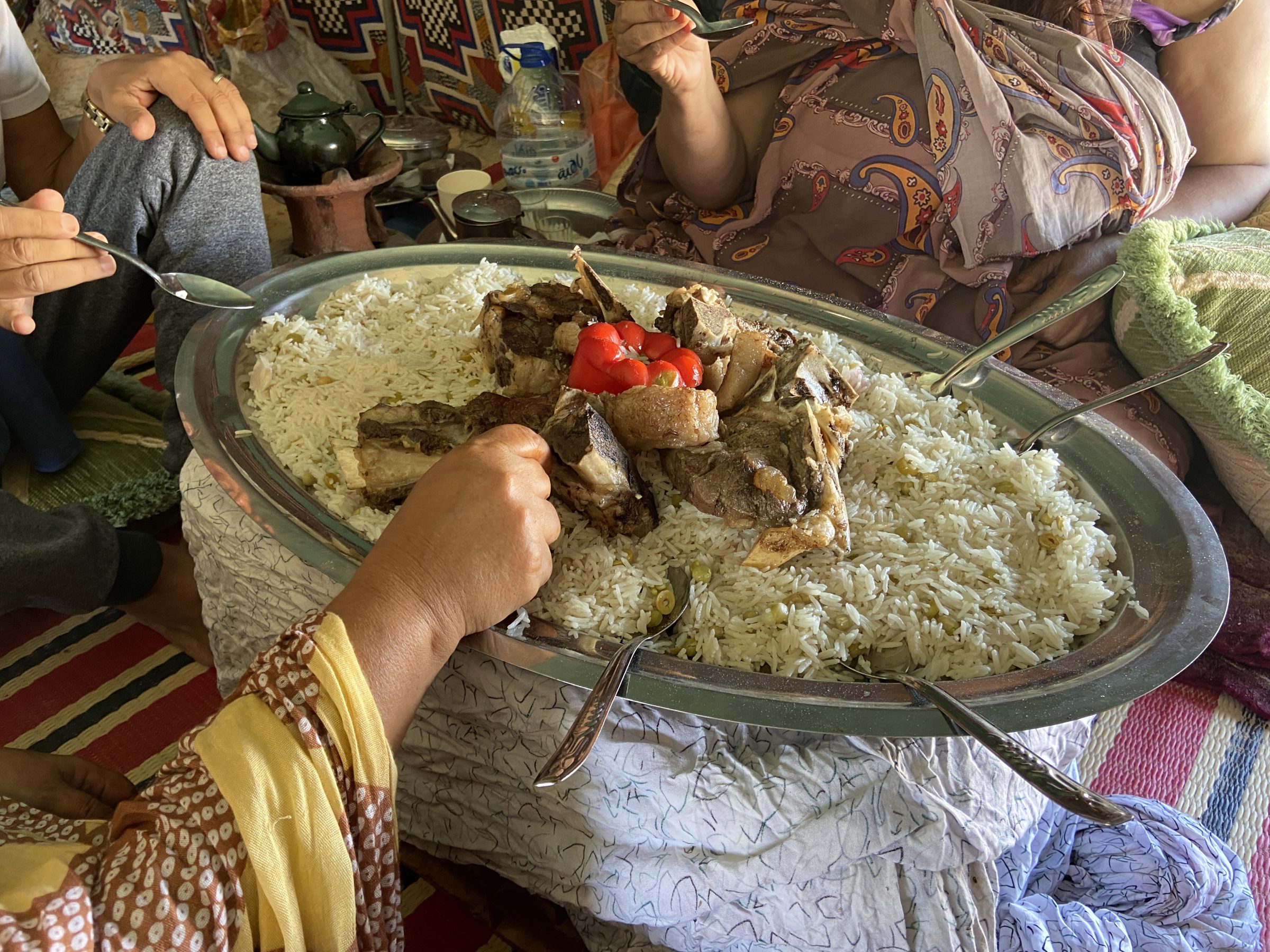
After this fantastic experience we get homemade yogurt and fruit. Then we all stretch out on the floor to relax.
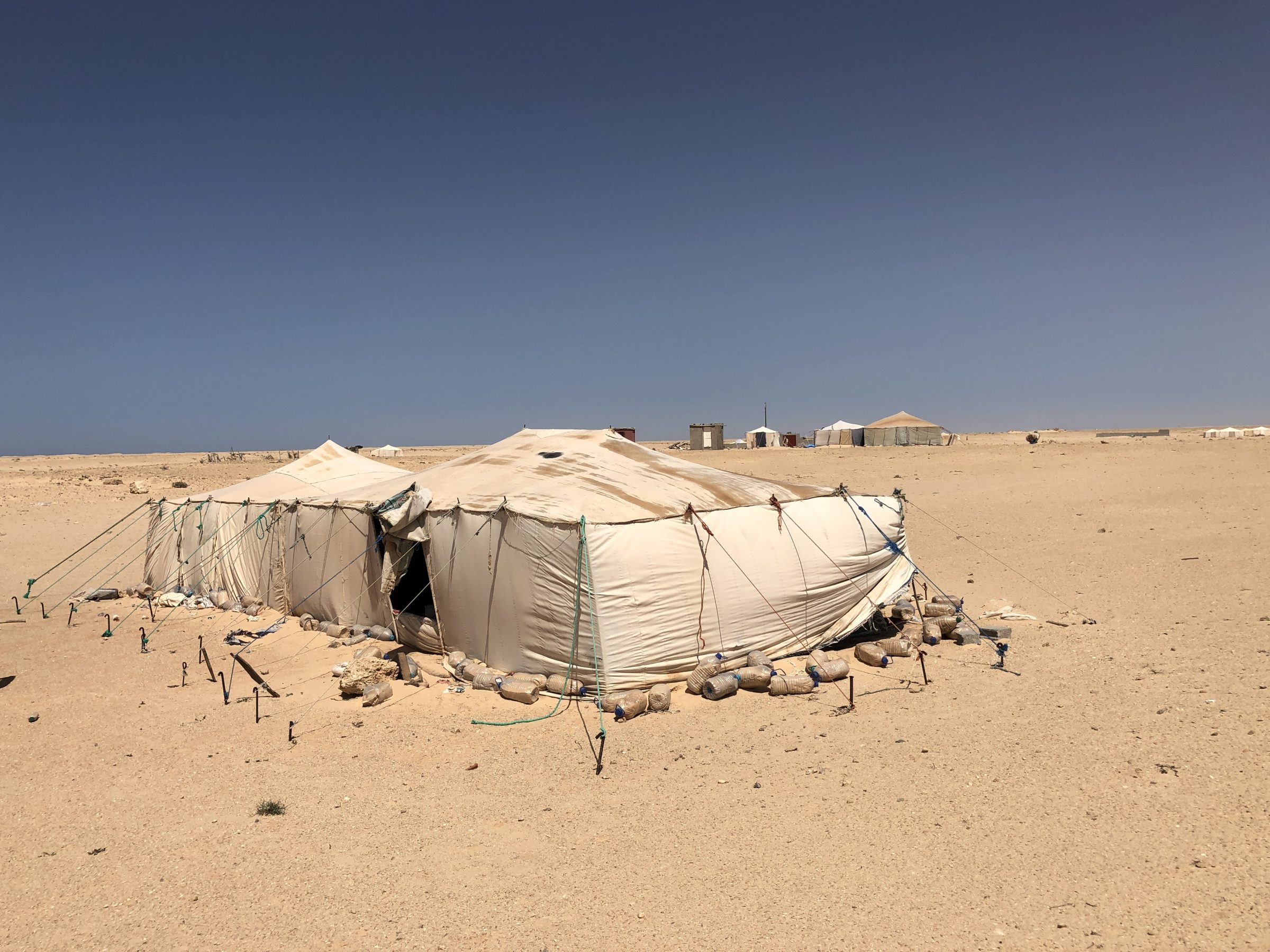
Desert shower and goodbye to Morocco
After we have recovered from the meal we clean up and drive back to the city. On the way it is possible to take a shower at a natural spring. It turns out to be a huge snake with warm, sulphurous water. We take off our clothes and let a servant take a full shower. The women keep their dresses on. We lie on the floor and have the greatest fun.
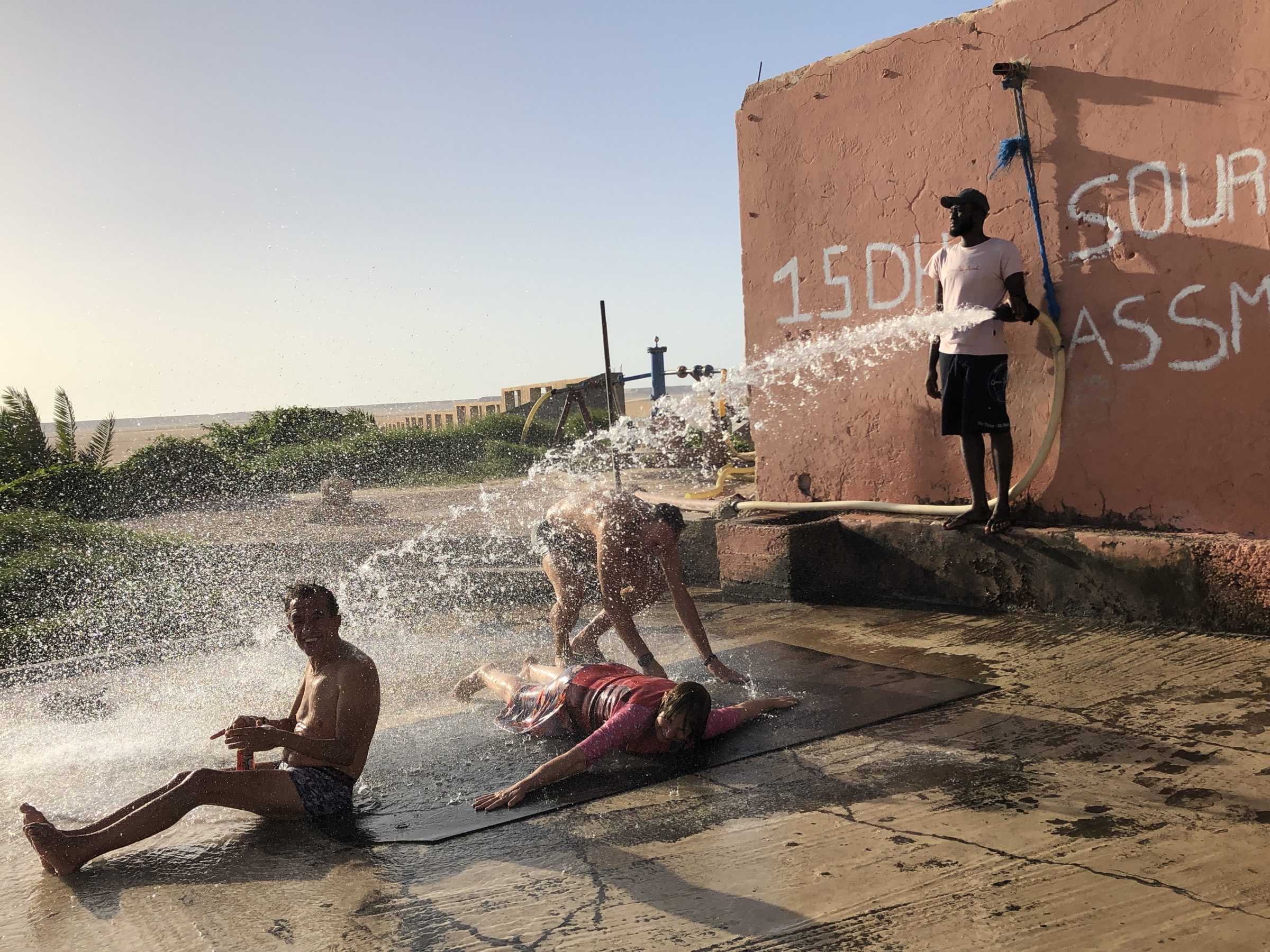
Then it's time to say goodbye. Always a difficult moment… Making friends and saying goodbye again.
We go back to the camper and find that the visit to Dakhla took two days longer than expected.
We look back with incredible pleasure on a big month of Morocco, what lovely people, what a warm welcome! Now we have to prepare to cross the border into Mauritania the next day. On the way to the next adventure, but more about that next time.


